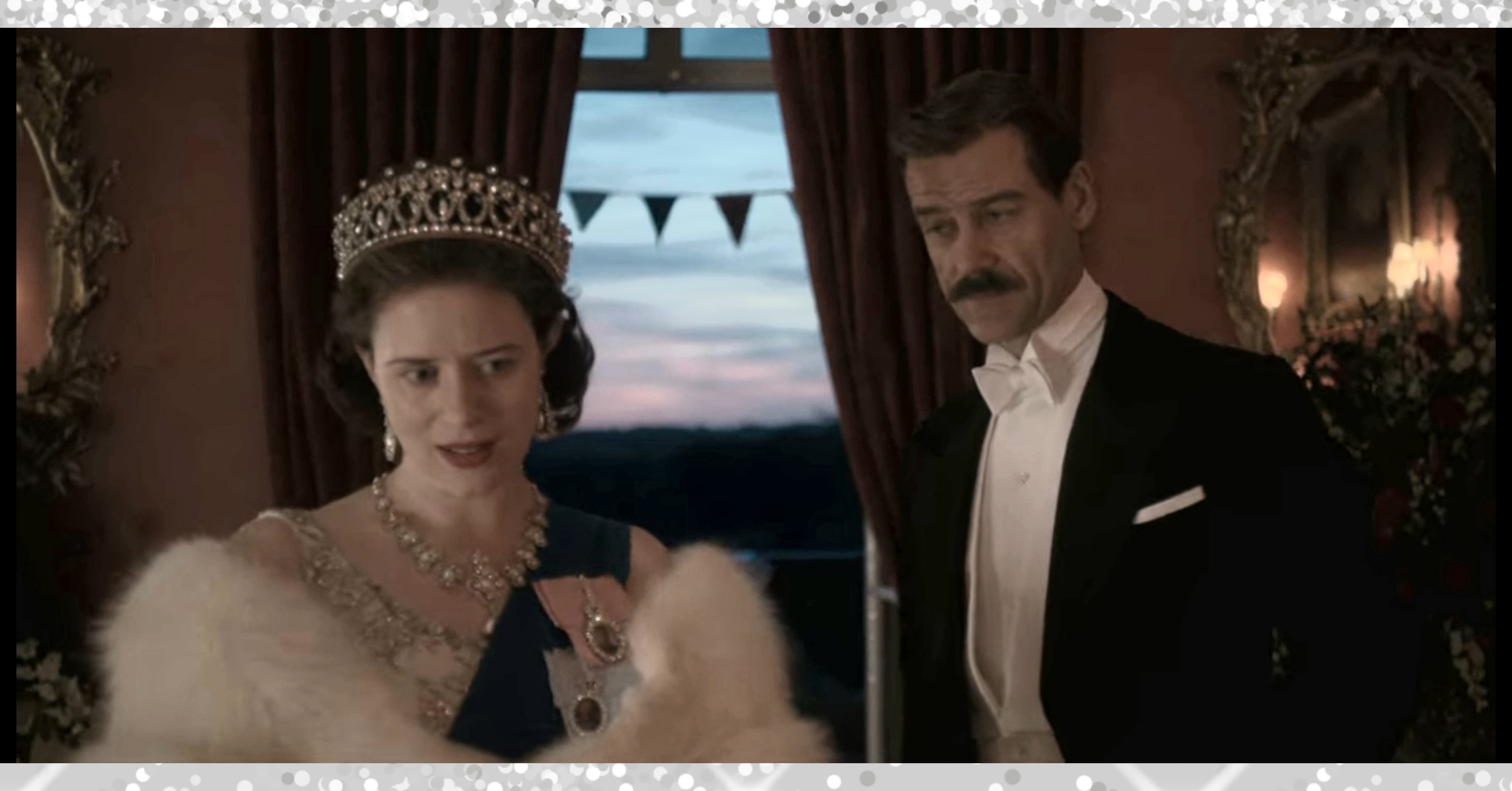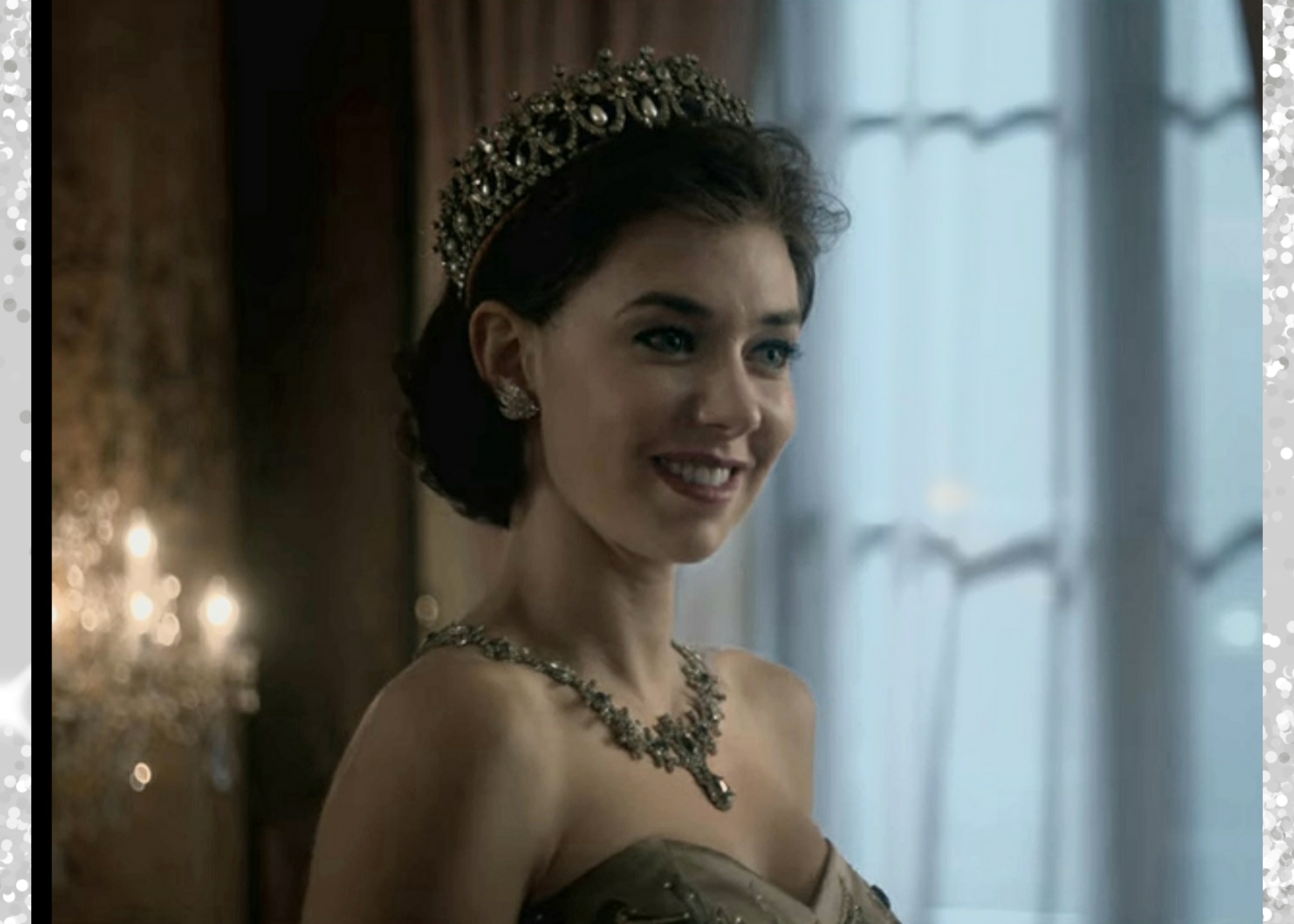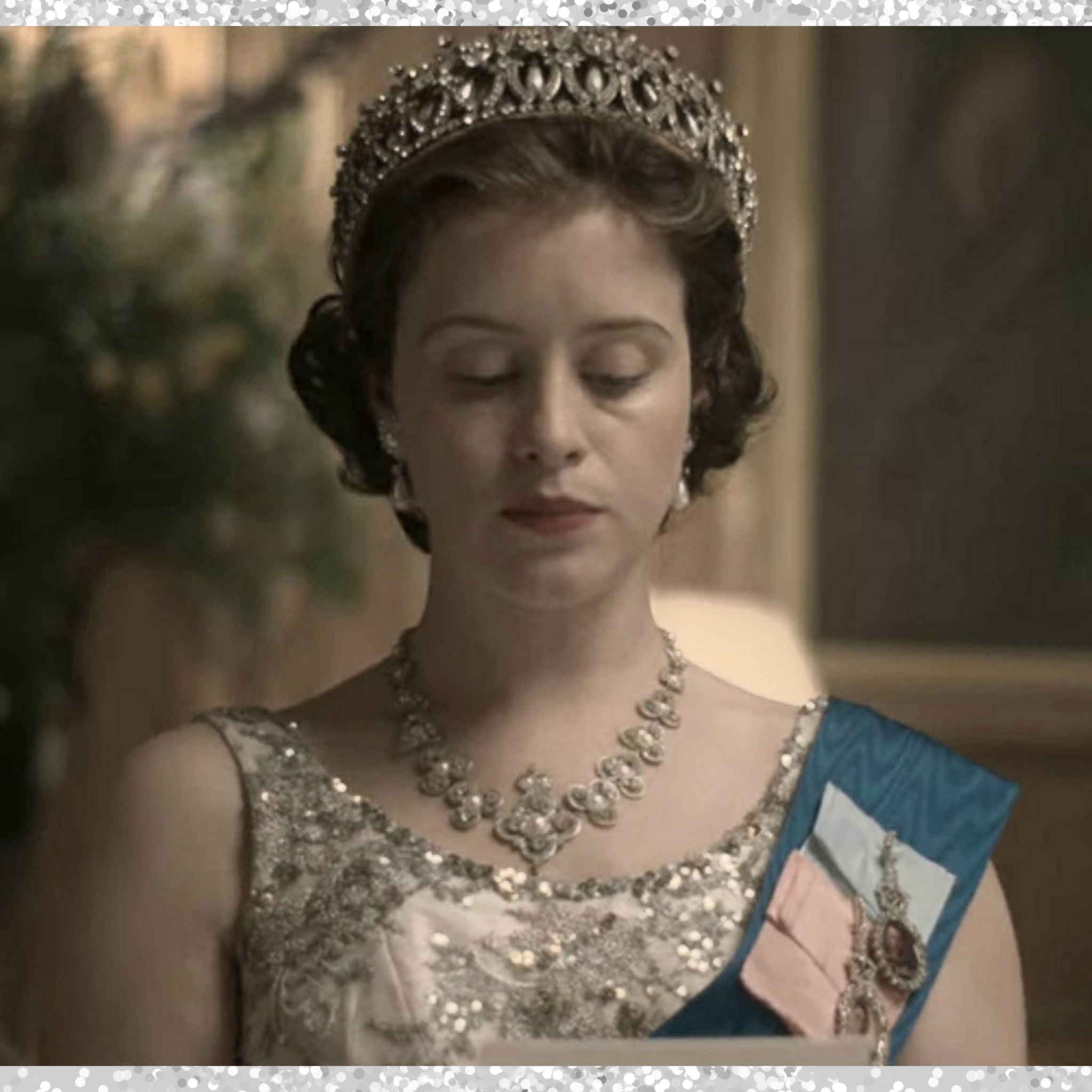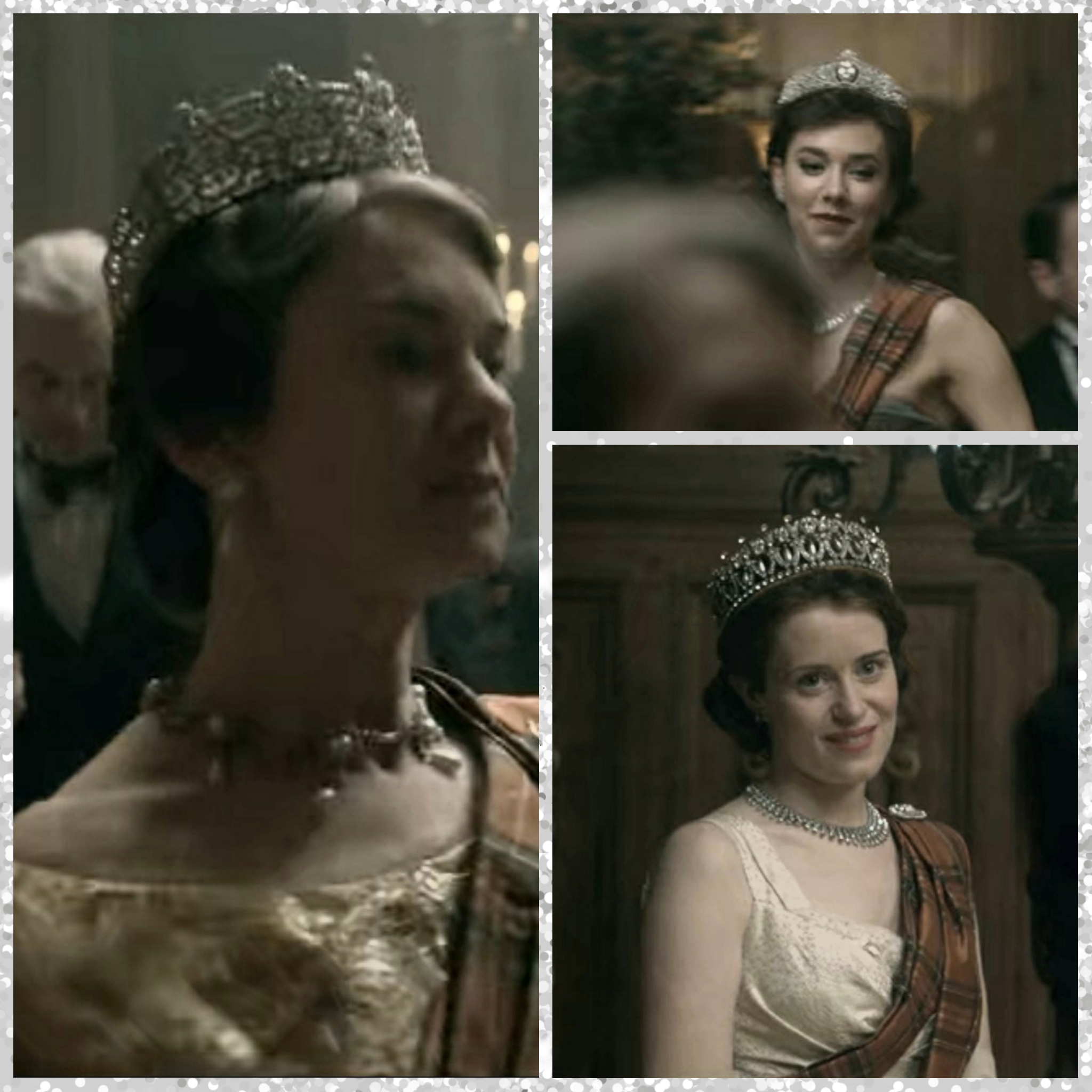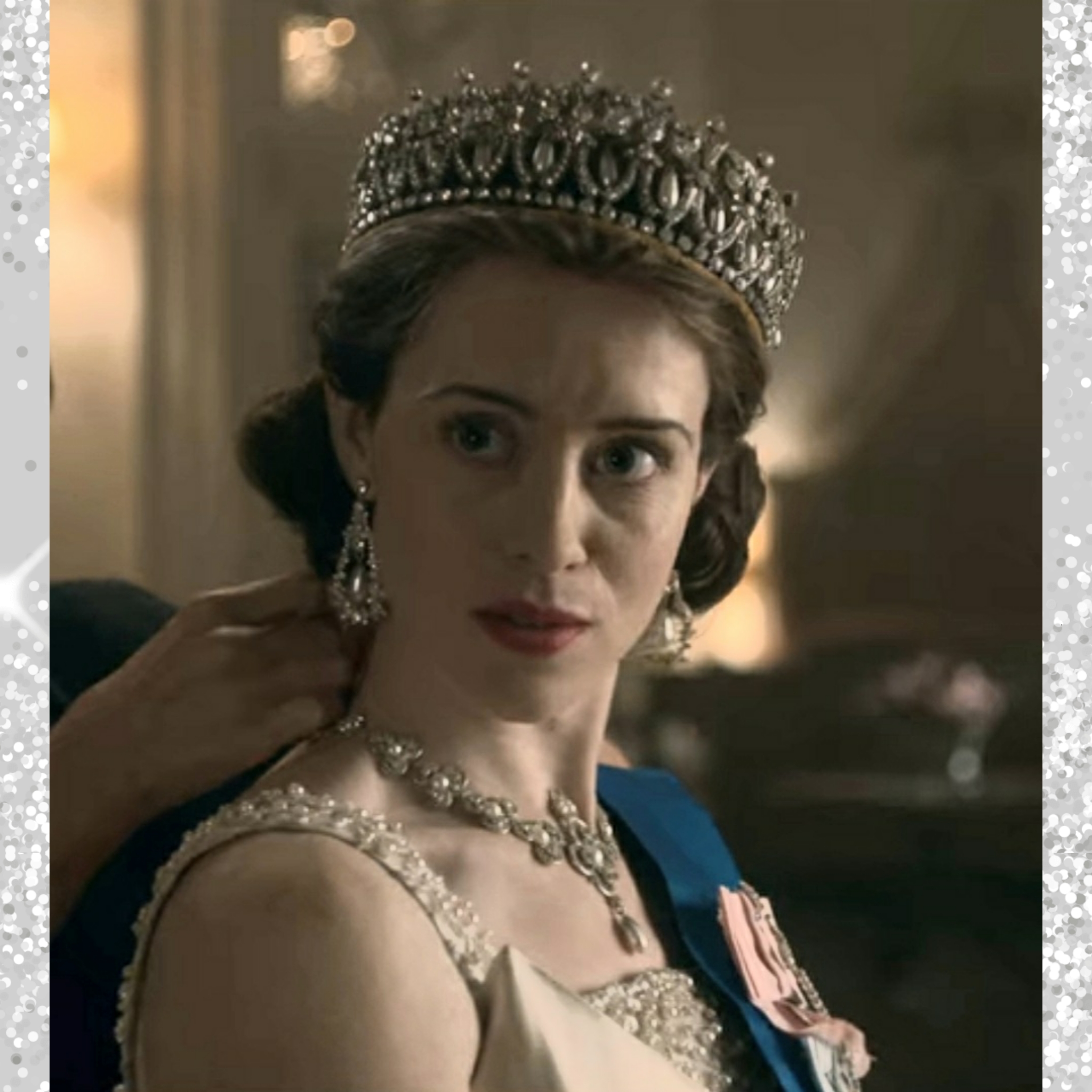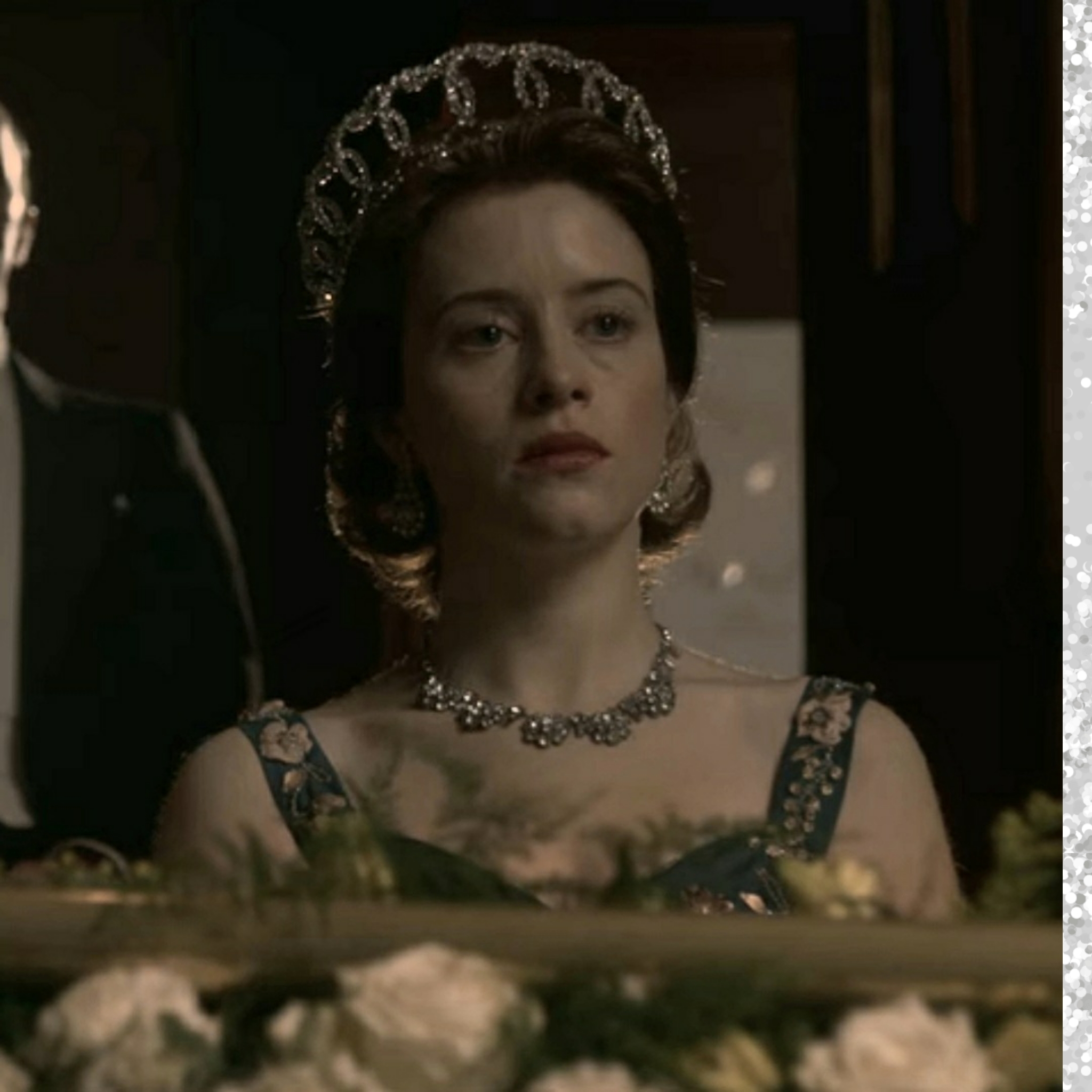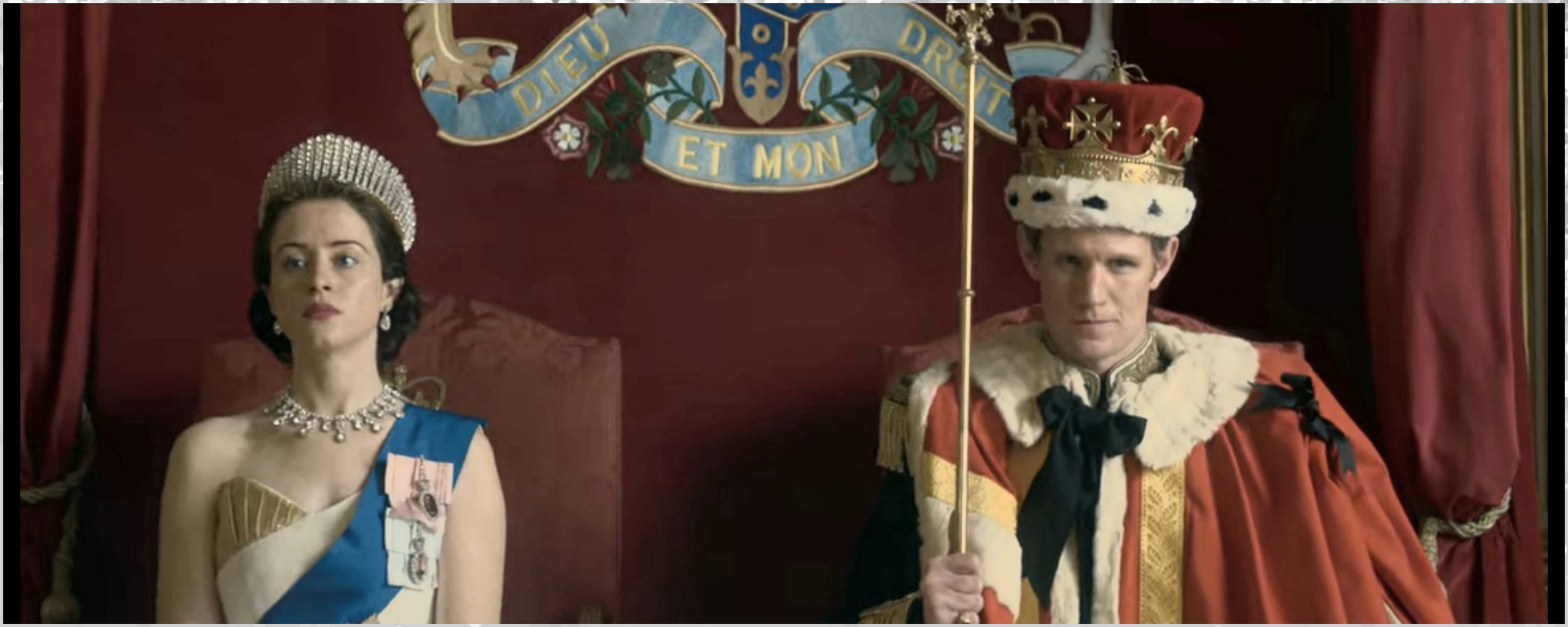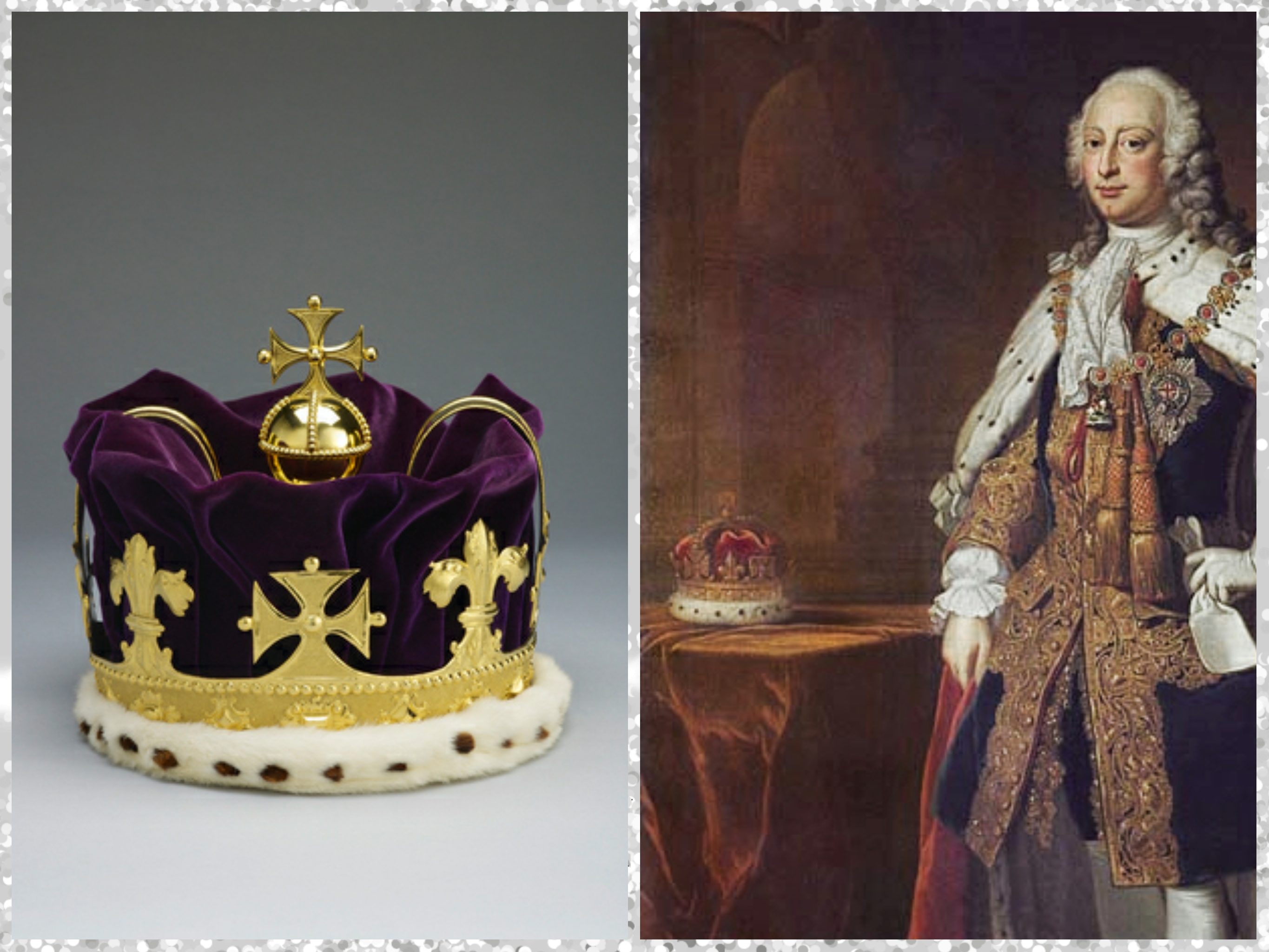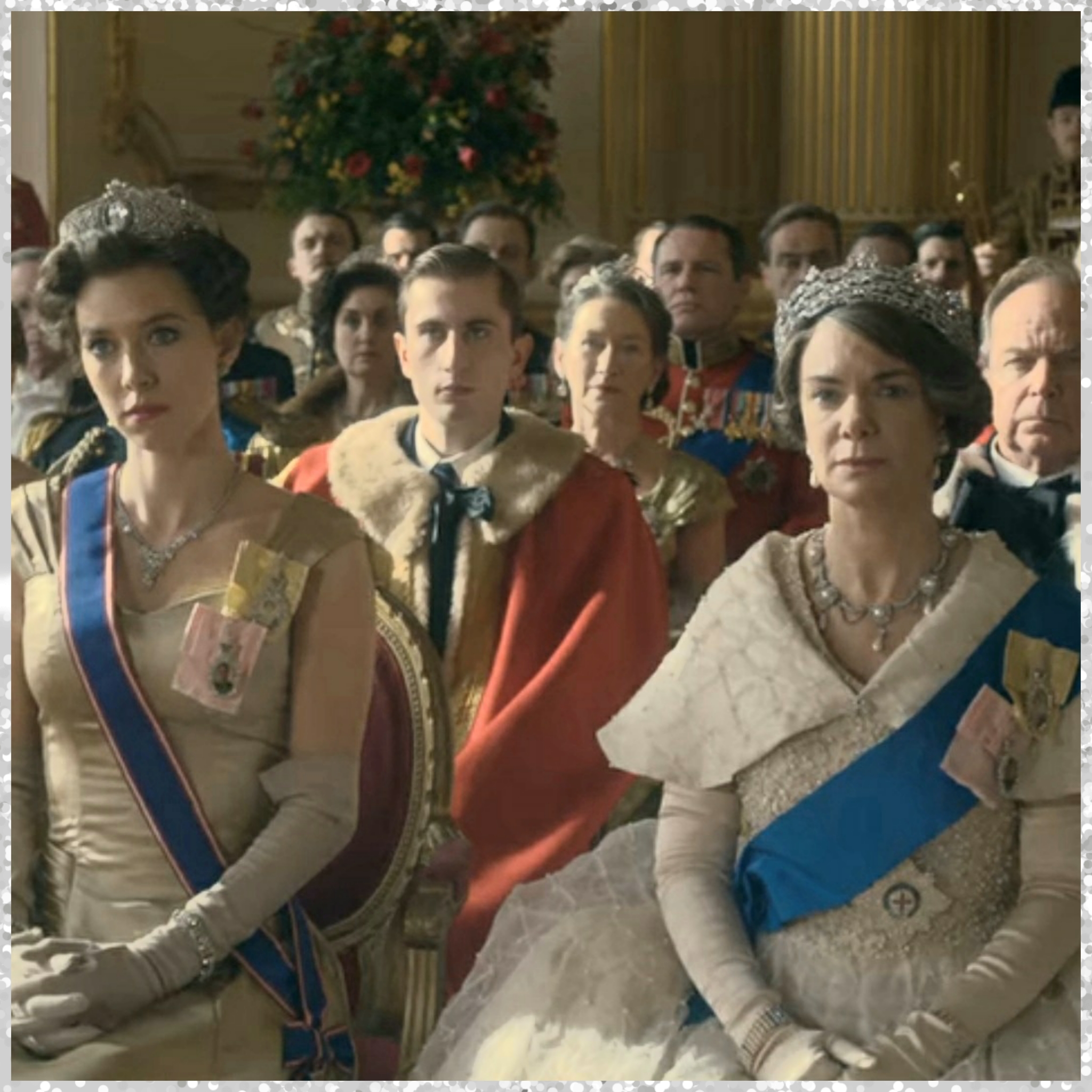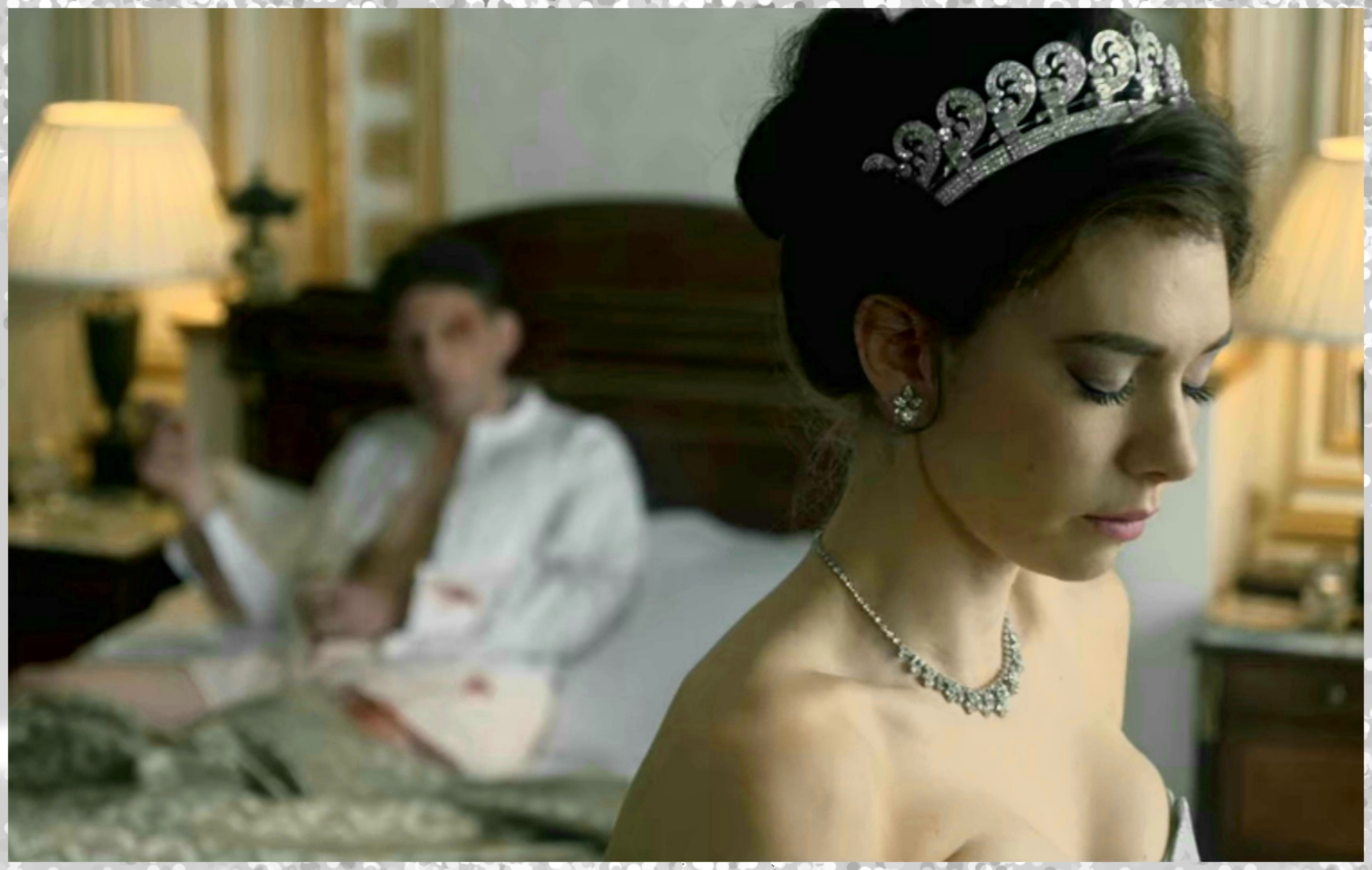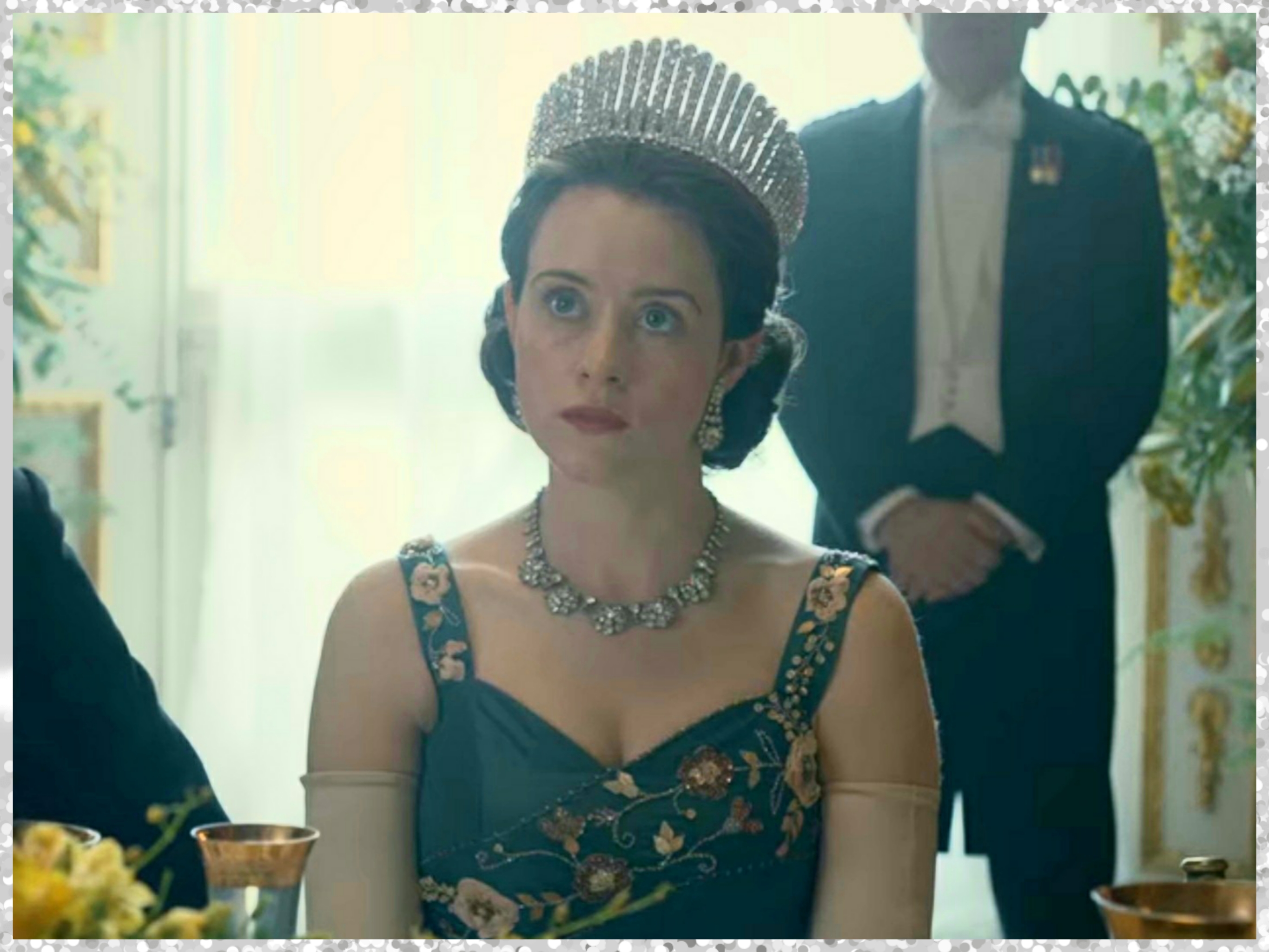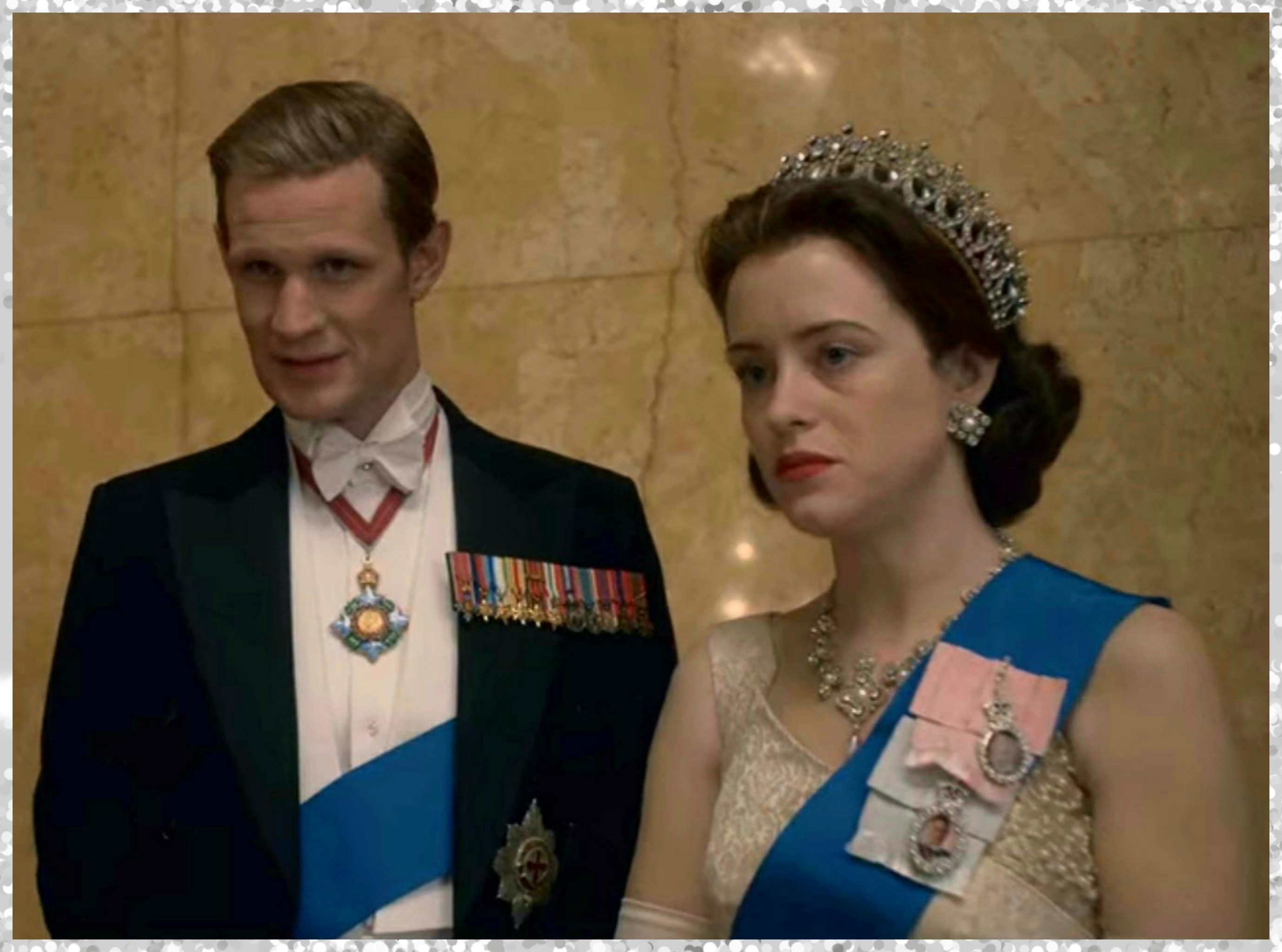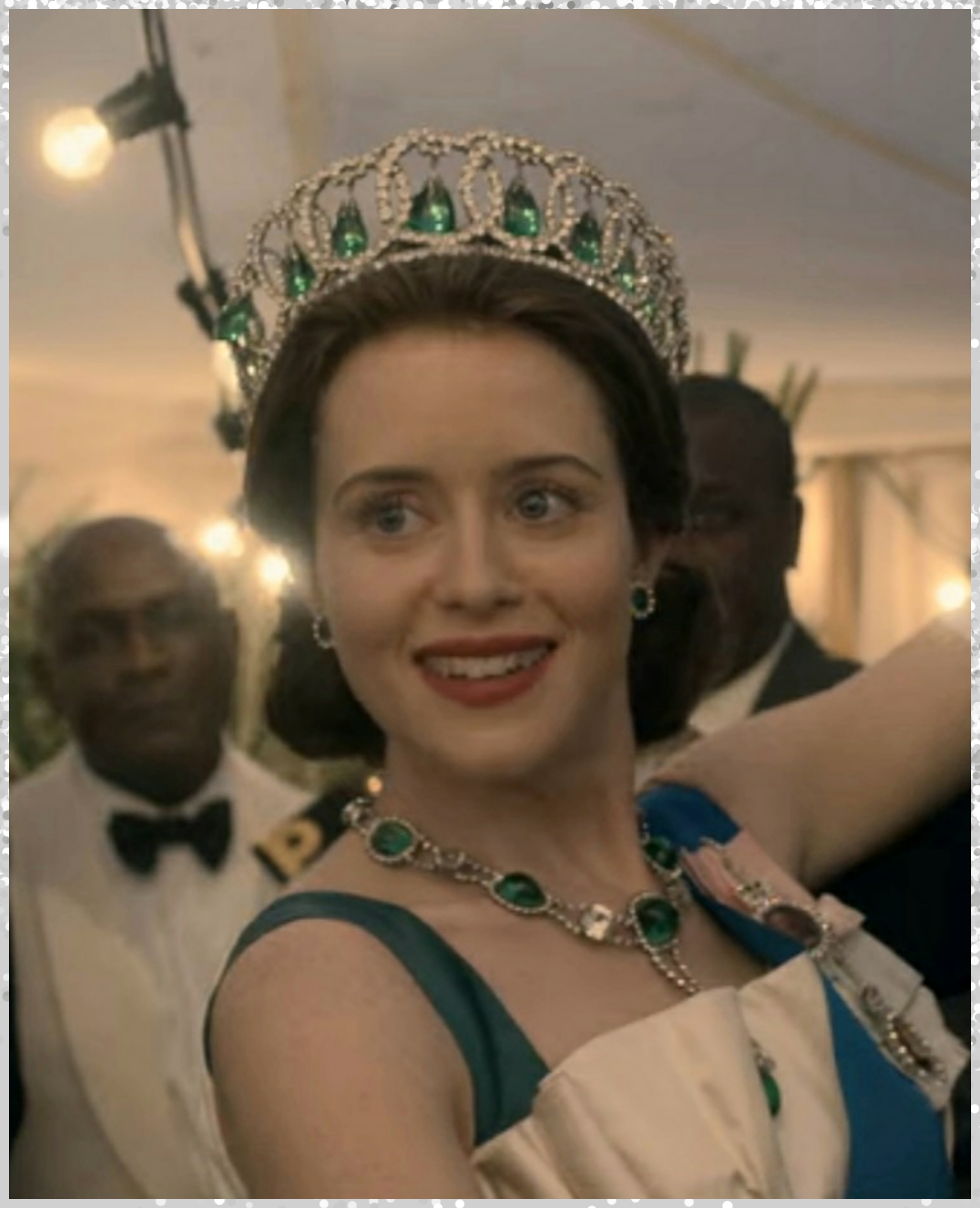During a recent re-watch of The Crown, I was struck by an exchange between Princess Margaret and her dresser. Princess Margaret is deputising for her sister, the queen, and is just about to put on her tiara when she has a thought:
“What about the state diadem tiara or the Cambridge lover’s knot?”
“Those are her majesty’s for state occasions.”
“Her majesty won’t mind and besides, are they not coming tonight expecting to meet a queen?”
The Crown Season 1 Episode 8: Pride and Joy
Now one part of me heard this and thought, ‘ah, they’re obviously trying to establish Margaret as the ostentatious one. I see what they’re doing. Let it go.‘ But another part of me, the part that has a blog devoted to history presented in historical fiction thought, ‘excuse you? The state diadem tiara? Her majesty’s for state occasions? You what, mate?‘
And so, here we are.
So, there are a number of issues with this scene which is pretty impressive given that it’s three lines of dialogue. The first being that while the dresser tells Margaret that the jewels she’s requested are part of the queen’s collection for state occasions, the tiara Margaret is using at this time belongs to that same collection. Secondly, the ‘state diadem tiara’ is not part of the queen’s jewels but part of the royal collection, an entirely different set of jewels (which are themselves entirely separate from the Crown Jewels). This particular diadem tiara is worn specifically by queens or queens consort at coronations or the state opening of parliament. Margaret wearing it would be a bit audacious, even for The Crown’s portrayal. Also, it’s known as the George IV State Diadem or the Diamond Diadem, calling it the diadem tiara is rather redundant. It’s like referring to a yacht as a ship boat.
Margaret’s other request, the Cambridge Lover’s Knot, is not part of the royal collection but part of the queen’s jewels (so very much belonging to ‘her majesty’) but its use is not limited to state occasions. As part of the queen’s private collection, she can wear it where she likes and loan it, as she does many of her jewels, to members of the royal family. As a small aside, a state occasion is an official function such as the Opening of Parliament. A formal dinner, like the one Margaret attends in this scene, even one with the presence of the royal family, does not a state occasion make. It’s also not called the Cambridge Lover’s Knot, but more on that soon! (I know, you can’t wait).
The Queen’s jewels, then. Where do they come from and do they actually belong to the queen?
The crowns and tiaras shown in ‘The Crown‘ are drawn from two main collections. First, there is the Royal Collection. The Royal Collection is made up of several elements which include a selection of gems, jewels and the Crown Jewels. The Crown Jewels, contrary to popular belief, do not refer solely to the crowns and sceptres kept at the Tower of London. The term ‘Crown Jewels’ applies to the large selection of regalia and objects used at the coronation, including but not limited to the actual jewels. Jewels in the Royal Collection might belong to the monarch personally or the monarch as an institution, passed down from one to the next.
The second collection are the jewels that belong to the queen, personally. These include pieces that have been commissioned or bought by the queen herself. While this collection contains historical pieces that have belonged to past queens, they are her personal property, inherited from other members of the royal family. It is from this collection that she loans her jewellery to other members of the royal family, including the tiaras worn by royal brides on their wedding days.
Many of the pieces, regardless of which collection to which they belong, have interesting and colourful stories behind them. It would be an undertaking, to say the least, to look at all the jewels the crown and the queen own, so instead we’ll have a look at the crowns, tiaras, diadems, ornamental headpieces, and any other related word as shown in The Crown.
Season 1 Episode 1: Wolferton Splash
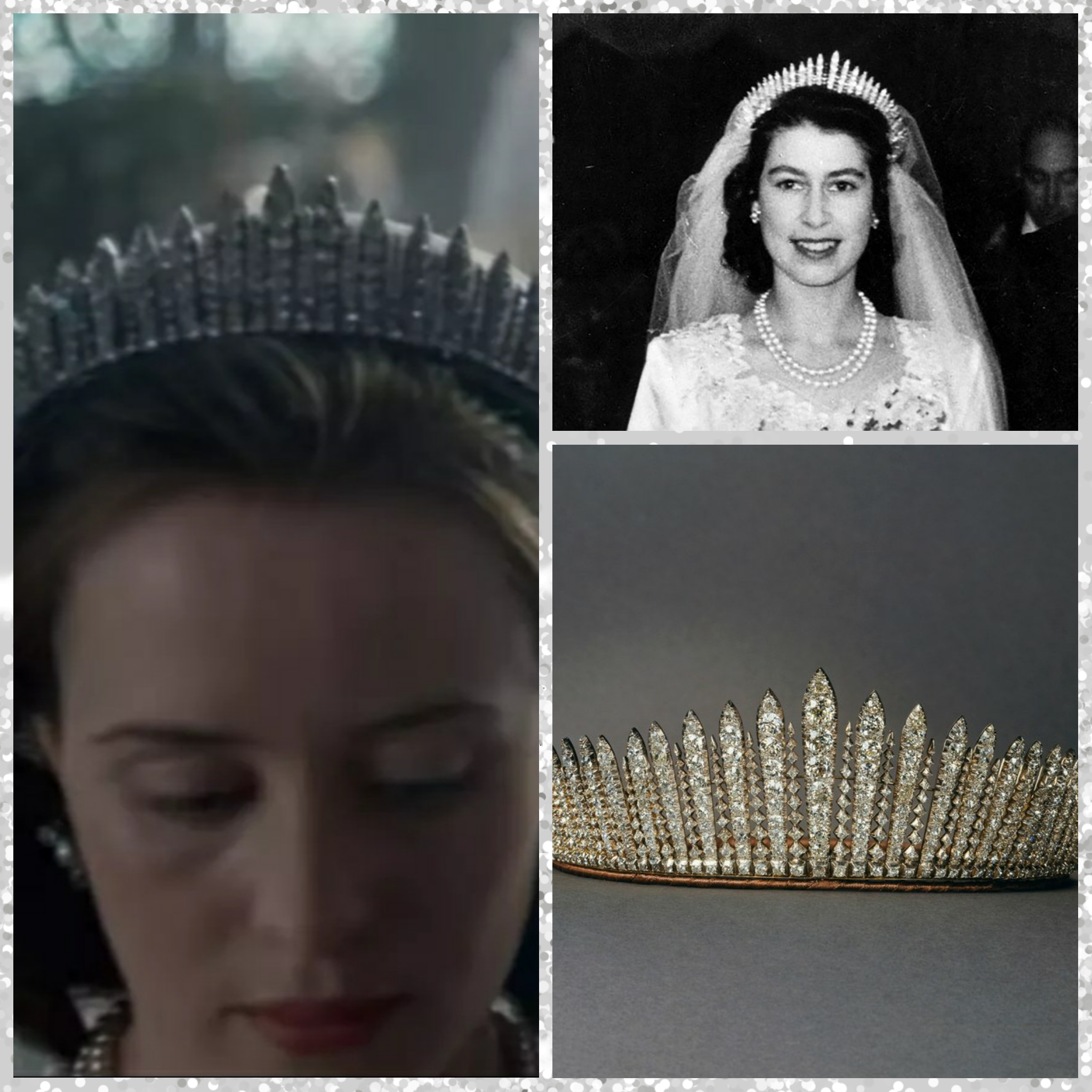
Only one tiara makes an appearance in the opening episode of the series; Queen Mary’s diamond fringe tiara, worn by Princess Elizabeth for her wedding. As the name suggests the tiara belonged to Mary of Teck, Elizabeth II’s grandmother and the wife of King George V. Many of the pieces belonging to the royal family are altered or adapted from existing pieces and the diamond fringe tiara is an example of this. The tiara began life as a fringe necklace given from Queen Victoria to the then Princess Mary as a wedding present, in 1893.
Mary was an avid collector of jewellery and had many pieces commissioned or altered. In 1919 she had the necklace mounted so that it could be worn as a tiara in the Russian kokoshnik style popular with the Romanovs. It could still, however, be worn as a necklace, something which caused problems on the morning of Princess Elizabeth’s wedding day.
At the time of the wedding, the tiara belonged to Queen Elizabeth, the Queen Mother and the princess wore it as her ‘something borrowed’. Apparently, unaware that the tiara was also a necklace, the princess accidentally touched or caught the clasp, causing the jewels to fall from their mounts. The Crown Jeweller was on hand to repair it and the princess was able to wear it down the aisle.
The tiara was also worn by Princess Anne at her wedding to Mark Phillips in 1973 and more recently, by Princess Beatrice when she married Edoardo Mapelli Mozzi in July 2020.
Season 1, Episode 3: Windsor
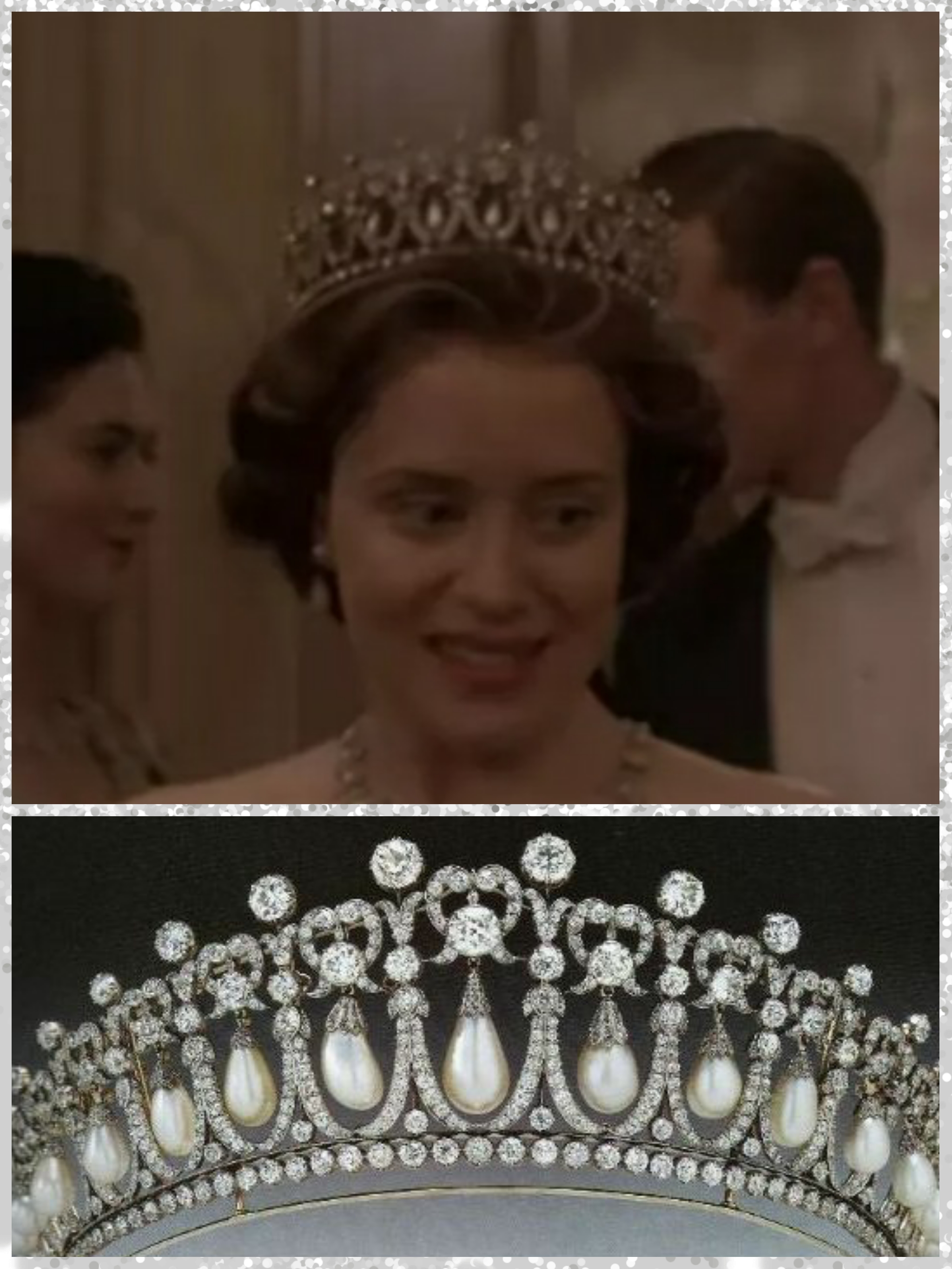
No crowns or tiaras appear in episode two of season one and it isn’t until late in the episode that one appears in episode three. It has gone by a few names in its time: the bow-knot tiara, Queen Mary’s bow-knot diamond and pearl tiara, Queen Mary’s lover’s knot tiara, the Cambridge lover’s knot tiara or just the lover’s knot tiara but it is one of the most recognisable tiaras in the queen’s collection, due to its popularity with Princess Diana. More recently, it has become the most worn tiara by the Duchess of Cambridge.
Once again, we can thank Queen Mary for this piece. In 1913, she commissioned the tiara from the House of Garrard, using pearls and diamonds already in her possession. The tiara has the option to be worn with an additional row of upstanding pearls, though it has not been worn as such since Queen Mary herself.
But wait, there’s more.
The Cambridge lover’s knot tiara is actually a completely separate piece that served as the inspiration for this lover’s knot tiara. The original piece was commissioned by George, Duke of Cambridge, in 1818 for his new bride, Queen Mary’s grandmother, Princess Augusta of Hesse-Kassel. The tiara remained in the family, passed down to Queen Mary’s aunt. Queen Mary obviously admired it enough to have her own version made, even if it is mistakenly referred to by the name of the original.
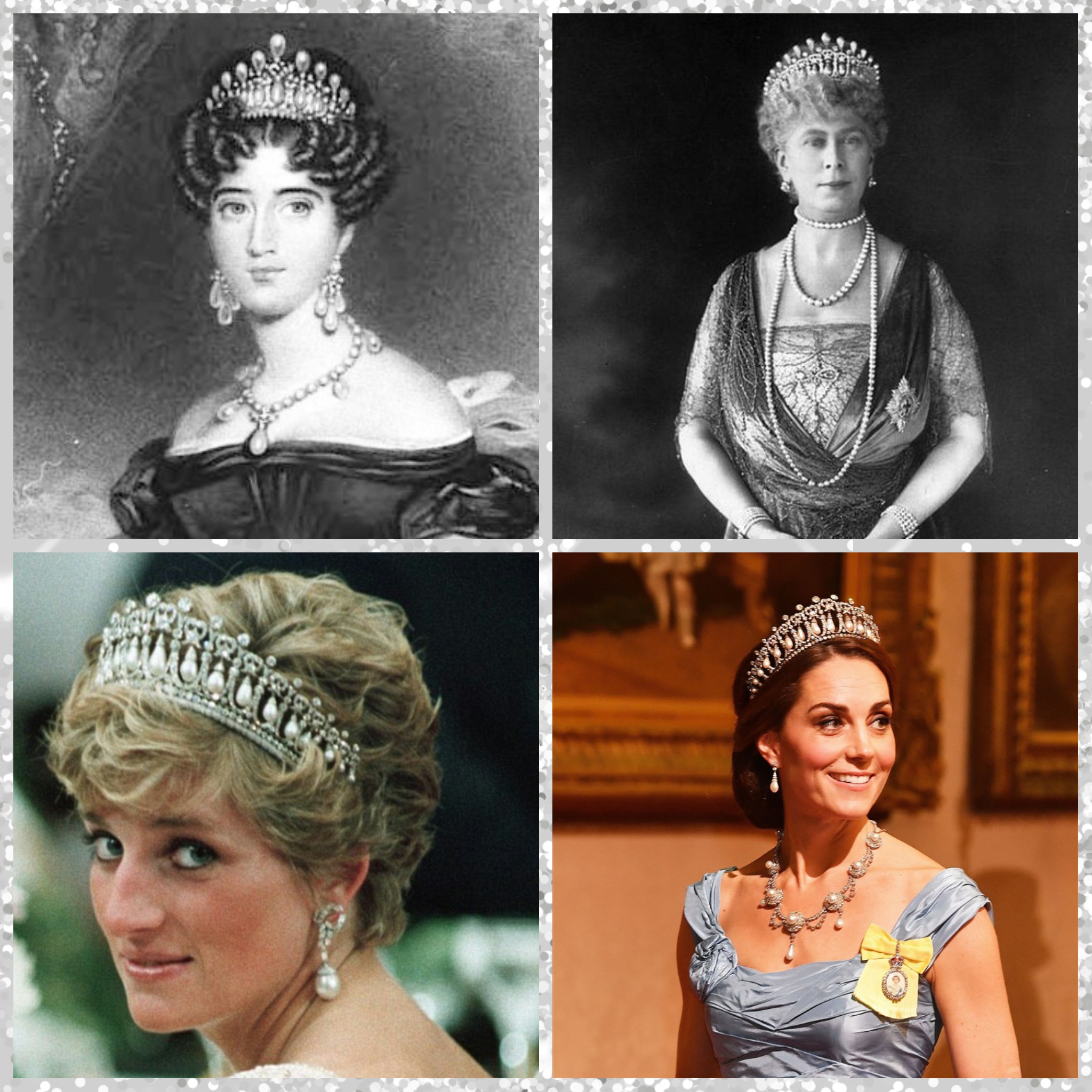
Season 1 Episode 5: Smoke and Mirrors
It’s Coronation Day! Lot’s of jewels and regalia on display this episode staring with the big one:
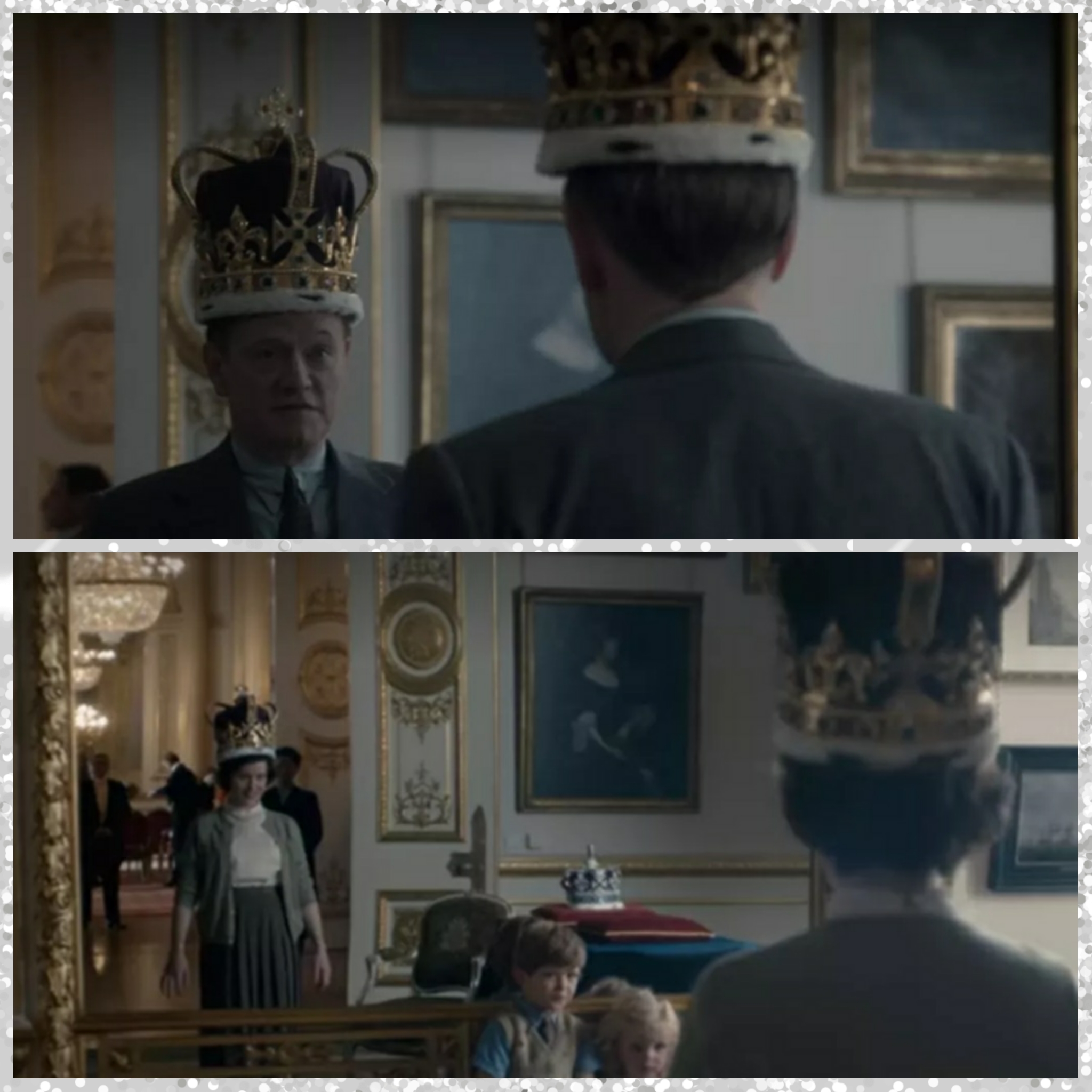
While the current version of St. Edward’s Crown was created in 1661 for the coronation of Charles II, there has been a St. Edward’s Crown since the time of its namesake. Edward the Confessor died in 1066 and canonised in 1161. His crown was maintained at Westminster Abbey and used in the coronation of later monarchs until the Interregnum (1649-1660). When the monarchy was restored in 1660, St Edward’s Crown was recreated in the style of the original. The goldsmith who created it did not bill Charles for materials, so it’s thought that the crown was made using the materials of the original.
Although Elizabeth was crowned with St. Edward’s Crown, she left the ceremony wearing the Imperial State Crown shown in the background above and in the scene below.
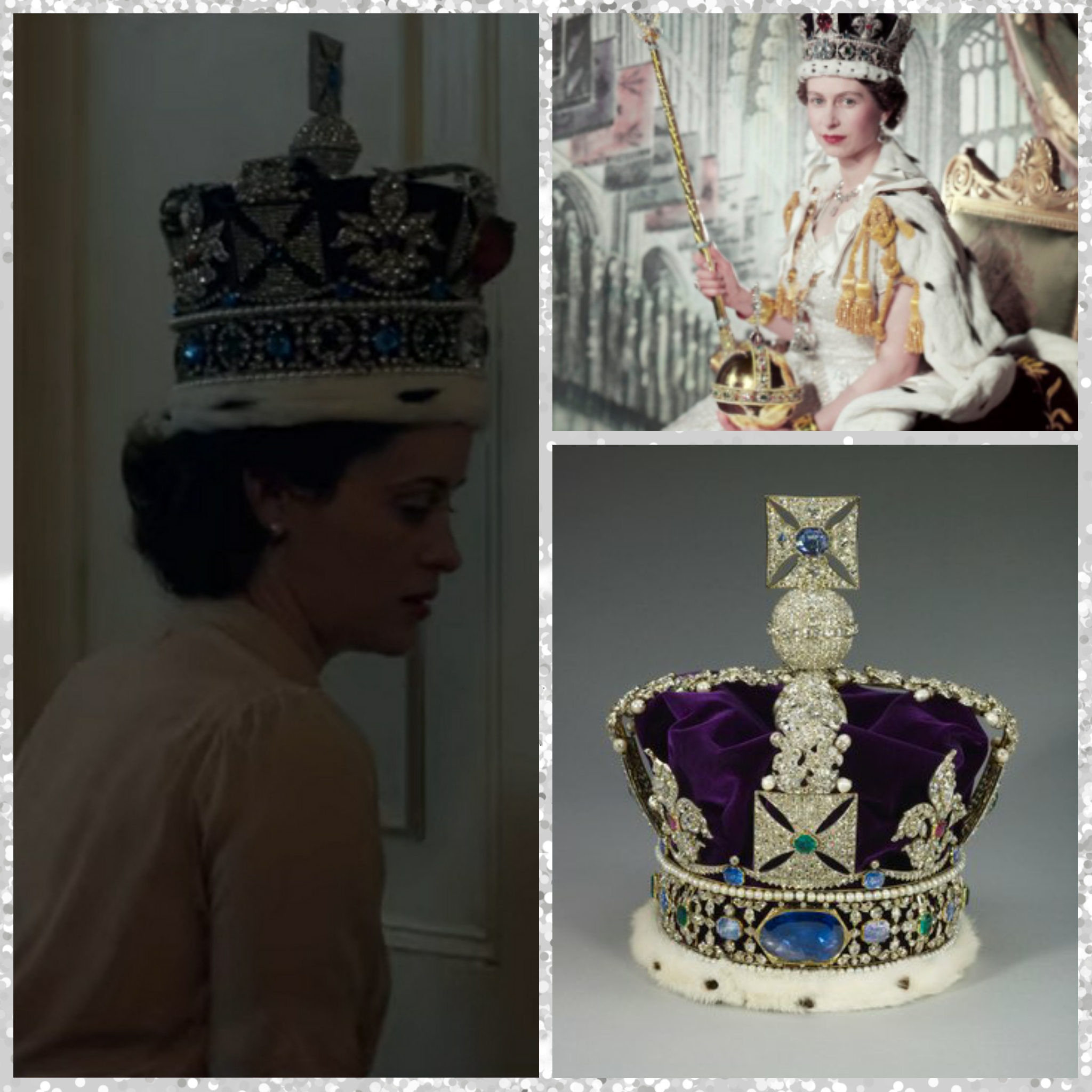
Like the St. Edward’s Crown, the Imperial State Crown has existed in various forms since it was created (in this instance, in the 15th Century). The current version was made in 1937 and adjusted for Queen Elizabeth’s coronation in 1953. It carries almost three thousand precious stones and includes some of the most significant of the Crown Jewels including; St. Edward’s Sapphire (1042 – thought to have been on Edward the Confessor’s coronation ring), the Cullinan II Diamond (1907), the Black Prince’s Ruby (1366 – acquired by Edward, the Black Prince) and the Stuart Sapphire (belonged to Charles II).
The episode is not limited to displaying the Crown Jewels though.
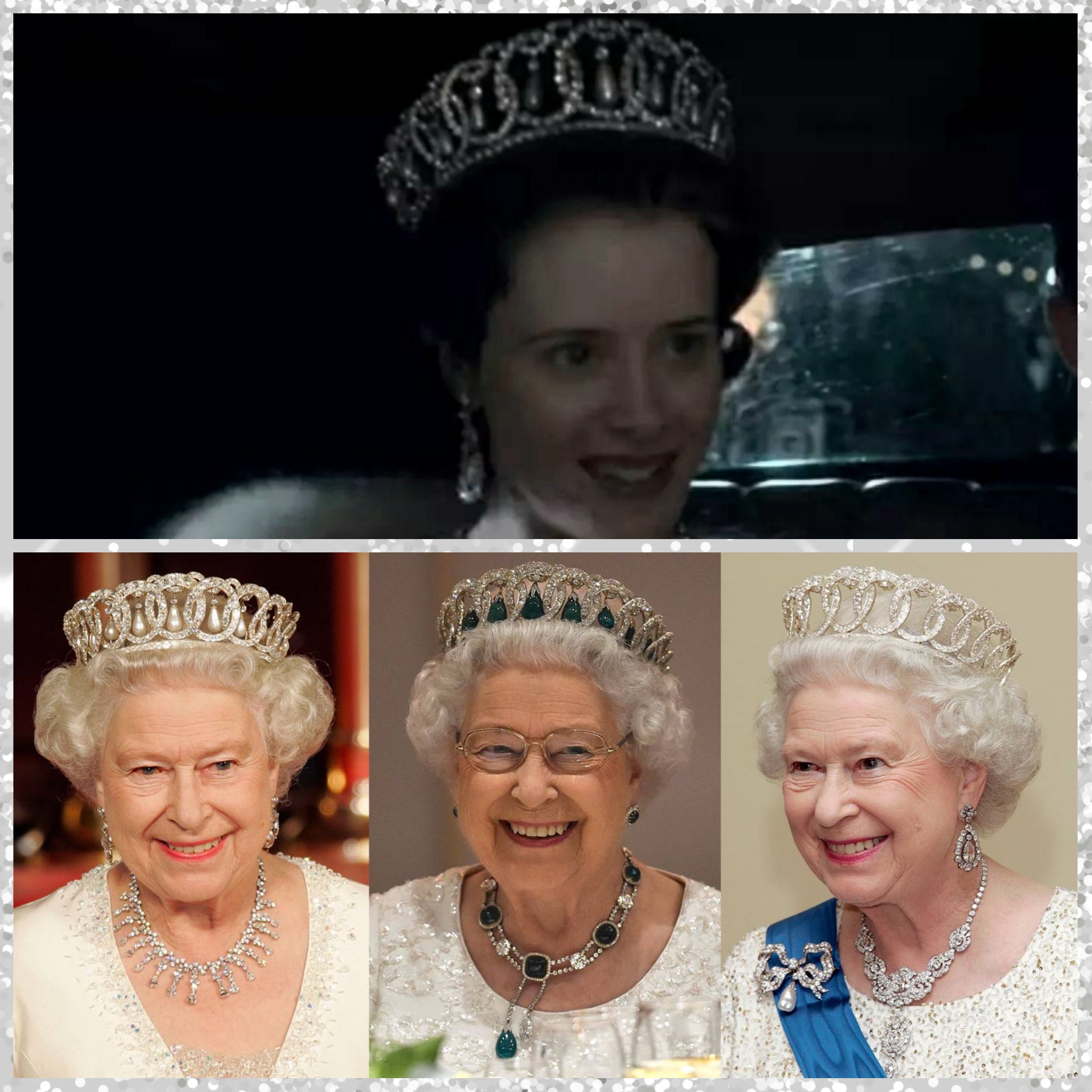
The Grand Duchess Vladimir tiara or the Diamond and Pearl tiara was bought by, you’ll be surprised to know, Queen Mary [insert dramatic gasps], but already had a rich history before it came to England.
The tiara was created for Duchess Marie of Mecklenburg-Schwerin when she married Grand Duke Vladimir Alexandrovich of the Romanovs in 1874. Following the Russian Revolution, Marie fled her home, leaving many of her jewels, including the tiara, behind in a safe. Later, her son and his British art dealer friend, disguised as workmen managed to gain access to Marie’s home and retrieved the jewels. They smuggled them into London, though the tiara was damaged in the process. Marie escaped later but her health took a turn for the worse and she died shortly after arriving in France in 1920.
Her jewels were inherited by her daughter Elena who decided to sell some of her mother’s jewels the following year. Queen Mary bought the tiara and as well as having it repaired, would have it adjusted to allow it to be worn with the Cambridge emeralds. (More on them later).
The coronation continues with the Crown Jewels on display and then Elizabeth is crowned. To a chorus of ‘long live the queen’ the gathered nobles put on their various coronets and we have this shot of the Queen Mother and Princess Margaret.
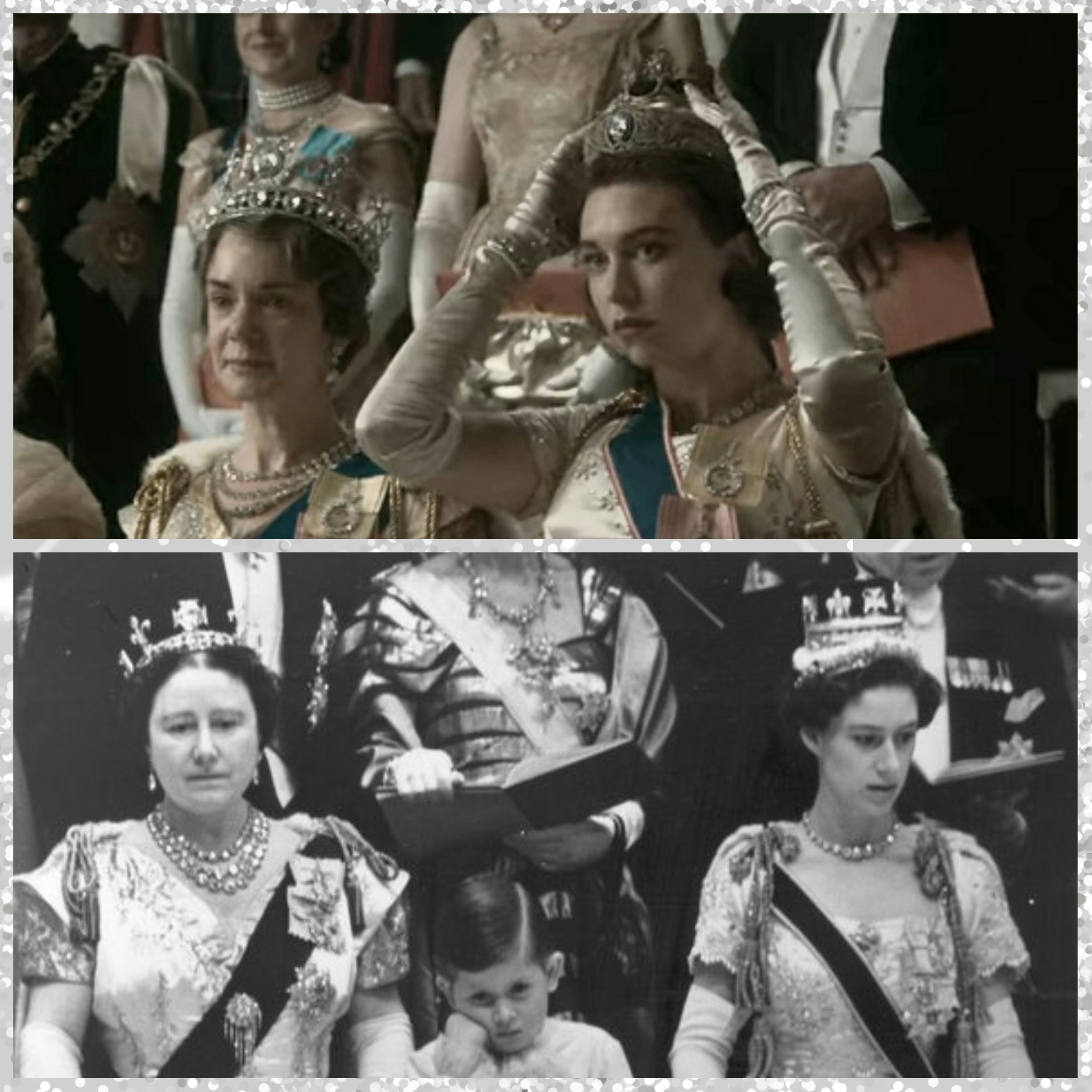
The tiara Margaret actually wore to the coronation of her sister, has been substituted for this mystery tiara. (More on that later, too). Victoria Hamilton as the Queen Mother on the other hand is wearing a rather ostentatious replica of the circlet element of her own crown. Queen Elizabeth’s Crown was made in 1937 for Queen Elizabeth using existing jewels and the Koh-i-Noor diamond.
Season 1, Episode 6: Gelignite
This episode is light on crowns with the focus instead on the relationship between Group Captain Peter Townsend and Princess Margaret. But we are treated to Tommy Lascelles looking particularly dashing while Queen Elizabeth sports [drum roll]…
The Lover’s Knot tiara.
Season 1, Episode 8: Pride and Joy
And, we arrive at the episode that started all this. With Margaret deputising for her sister and wanting to borrow her jewels.
We begin with Princess Margaret’s mystery tiara from the coronation. Truth be told, I don’t know which tiara it is or is meant to be a replica of but I’ve found two similarly styled pieces.
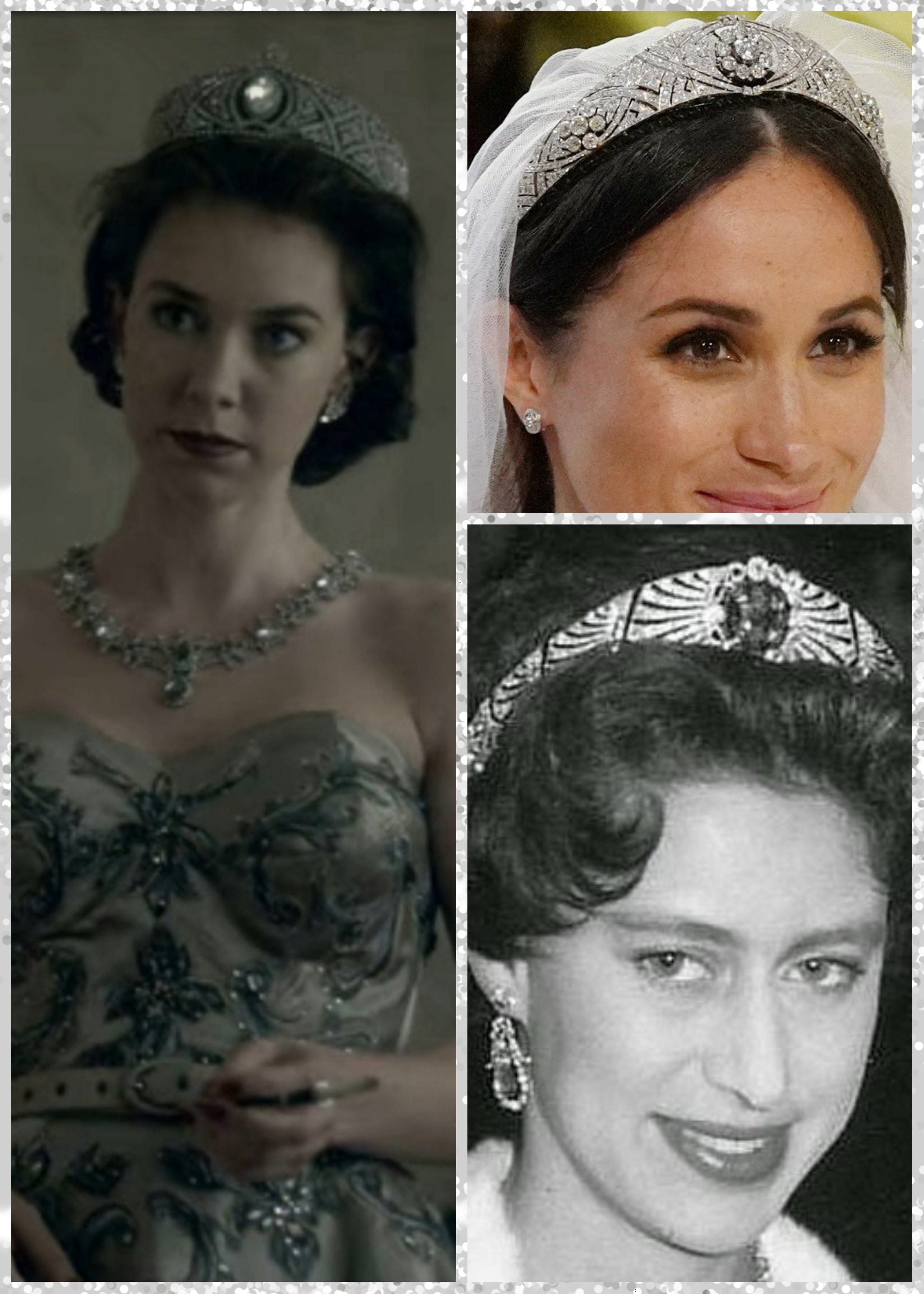
The jewels in The Crown are of course replicas which means they’re not always going to look spot on. I think (and this is just a guess) that Margaret’s mystery tiara might be either Queen Mary’s Bandeau Tiara or Queen Mary’s Sapphire Bandeau. The stone in the centre of the Sapphire Bandeau could be removed and worn as a brooch and as the queen loaned Princess Margaret the tiara, its likely this forms the basis for Margaret’s tiara. The design of the tiara itself however looks more like Queen Mary’s Bandeau Tiara. You’ll notice something about these two tiaras though and that is that they’re both referred to as ‘Queen Mary’s…’ Once again, it was Queen Mary who acquired these pieces.
In 1932, Queen Mary had a bandeau made to showcase a brooch she had been given by the county of Lincoln on the occasion of her marriage in 1893. The brooch is detachable and the tiara was worn by Meghan Markle when she married Prince Harry.
Queen Mary’s Sapphire Bandeau is sometimes referred to as Marie Feodorovna’s Sapphire Bandeau. Marie Feodorovna was born a princess of Denmark before her marriage in 1866 to the Tsesarevich, Alexander Alexandrovich Romanov (later Alexander III of Russia). Whether the bandeau belonged to Marie is a matter of some debate, but it is thought that Queen Mary acquired the sapphire used in the bandeau (which may or may not have belonged to Marie) in a sale of her jewels in 1921.
Regardless of which tiara it’s meant to be, Margaret doesn’t want to wear it and she is triumphant. In the next scene we see her wearing…
The Lover’s Knot! Gasp!
Season 1 Episode 9: Assassins
Another jewellery light episode that focuses more on Phillip and Elizabeth’s marriage, and the Prime Minister than on formal functions. The closing scenes however, have the queen attending Downing Street for a dinner in honour of the recently retired Winston Churchill. Once again, we’re treated to the Lover’s Knot.
With only one episode left of the season, the Lover’s Knot has appeared more than any other tiara in the Queen’s collection.
Season 1, Episode 10: Gloriana
A fair few jewels on display in this episode which highlights the friction between Elizabeth’s role as queen with her position as a daughter, sister and wife. A gathering at Balmoral shows off some important pieces.
The Queen wears the Lover’s Knot, as standard at this point. Margaret wears her mystery bandeau, but the Queen Mother wears something we haven’t seen in the series yet; The Greville Tiara. (Not to be confused with the Greville Emerald Tiara worn by Princess Eugenie for her wedding).
Unlike many of the other pieces featured here, this piece had nothing to do with Queen Mary. Instead, it became the property of the Queen Mother in 1942. The tiara began life with no royal connections, having been made in 1921 for Margaret Greville, socialite and close friend of Queen Mary. Greville commissioned it from Boucheron in Paris, using an existing Boucheron tiara so as to recycle the stones. She left the tiara and much of her jewellery collection to the Queen Mother upon her death. The Queen Mother had the tiara altered in 1953 by Cartier and it became one of her favourite pieces. Though now the property of the queen, she hasn’t worn it in public and instead has loaned it to Camilla, Duchess of Cornwall.
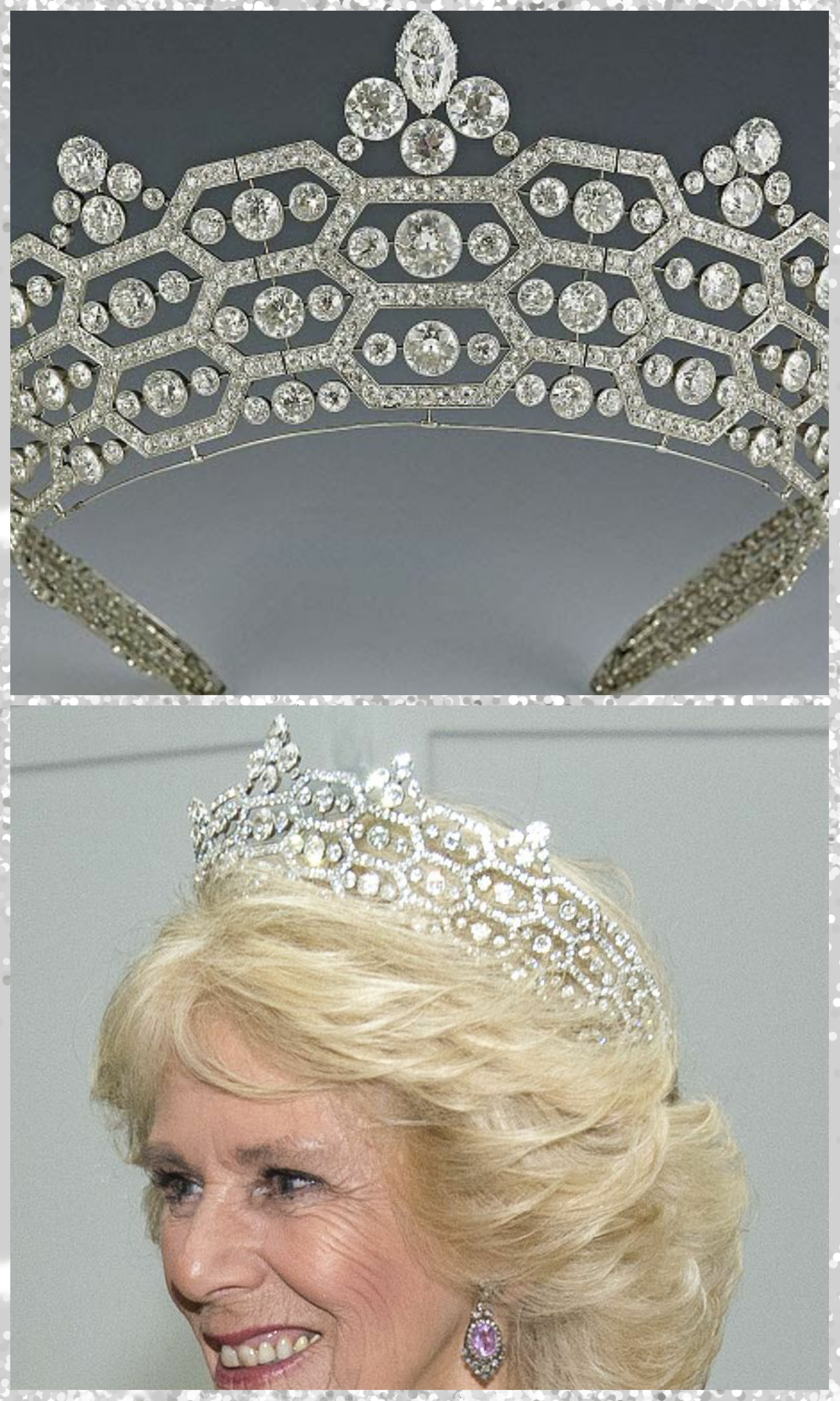
Ultimately, the Crown wins over Elizabeth’s individuality and the season ends with a photo shoot of Elizabeth looking every inch the queen she is.
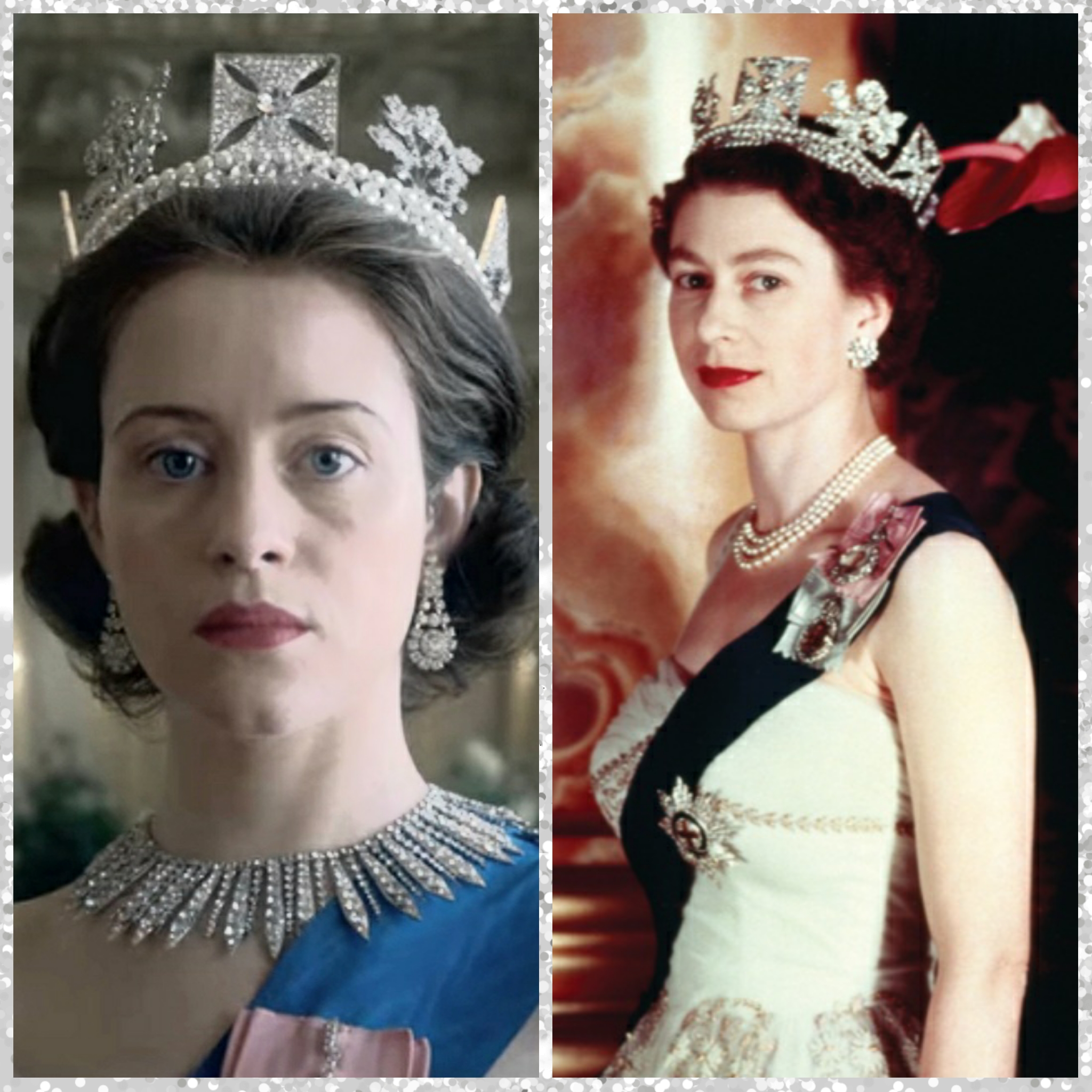
At first glance, it might look like she’s wearing Queen Mary’s diamond fringe tiara as a necklace but you would be wrong! It’s actually an entirely different fringe necklace given as a wedding gift to the queen in 1947. On her head, she wears the George IV State Diadem, otherwise known as the Diamond Diadem. This is the diadem, Margaret requested in episode eight, but wouldn’t have been allowed to wear.
Created in 1820 by Rundell and Bridge for George IV’s coronation, the diadem was declared an heirloom of the crown by Queen Victoria. This means it passes from queen to queen, and it has been worn by every queen since at state or private, family functions. It’s most recognisable as the crown the queen wears on postage stamps and coins.
Season 2, Episode 1: Misadventure
Claire Foy’s second season as queen opens with marital problems between Elizabeth and Philip before flashing back to happier times five months earlier. Elizabeth and Philip are getting on famously and he remarks that she looks nice in what she terms “full-battle dress”.
“That stuff used to wear you, now you wear it.”
The Crown, Season 2 Episode 1: Misadventure
What exactly is she wearing?
Wait for it…
It’s only the Lover’s Knot!
All is not well for long, when Elizabeth discovers a portrait of a ballerina in Philip’s luggage. She later goes to the ballet to where the ballerina in question is performing. Interestingly, they chose to feature Galina Ulanova as the potential mistress rather than a fictional dancer. There is nothing to suggest that Galina Ulanova had an affair with Prince Philip, assuming they ever met at all.
A rather mournful Elizabeth chooses to wear the Grand Duchess Vladimir Tiara, which we have seen in season 1. This time, however, she wears it without the pearl or emerald attachments.
Season 2 Episode 3: Lisbon
No jewels in episode two, which focuses more on Philip’s time away from London than on the queen’s engagements. Episode three, likewise, has little in the way of sparkle but then pulls out all the stops for the creation of Philip as a Prince, complete with his own mini coronation.
In this scene, which I think was fabricated for the show, Philip is crowned with the Coronet of Prince Frederick. The coronet was made for Frederick, Prince of Wales in 1728. He never wore it but he was painted with it in numerous portraits. The coronet itself was a part of the Honours of Wales which are the Crown Jewel equivalents for the investiture of the Prince of Wales. Since the investiture of Prince Charles in 1969 which required a new coronet to be made, Frederick’s coronet became part of the Crown Jewels.
It’s an interesting choice in crown for Philip, given that the coronet is specifically made for the Prince of Wales or the heir apparent, of which Philip is neither. But, I suppose they just wanted to give him a fancy crown and didn’t have anything else based in reality to crown him with.
The queen is also wearing a new piece to the show. Though it may resemble Queen Mary’s Diamond Fringe Tiara, it’s actually the Russian Fringe Tiara or Queen Alexandra’s Kokoshnik Tiara. Created by Garrard’s, the tiara was a gift to Queen Alexandra, then Princess of Wales for her silver wedding anniversary in 1888 by the ‘Ladies of Society.’ Alexandra of Denmark married the man who would be King Edward VII in 1863 and had apparently always wanted a tiara in the style of kokoshnik headdress, like her sister, Maria Feodorovna. The gift became one of her favourite tiaras and upon her death was passed to Alexandra’s daughter in law, Queen Mary.
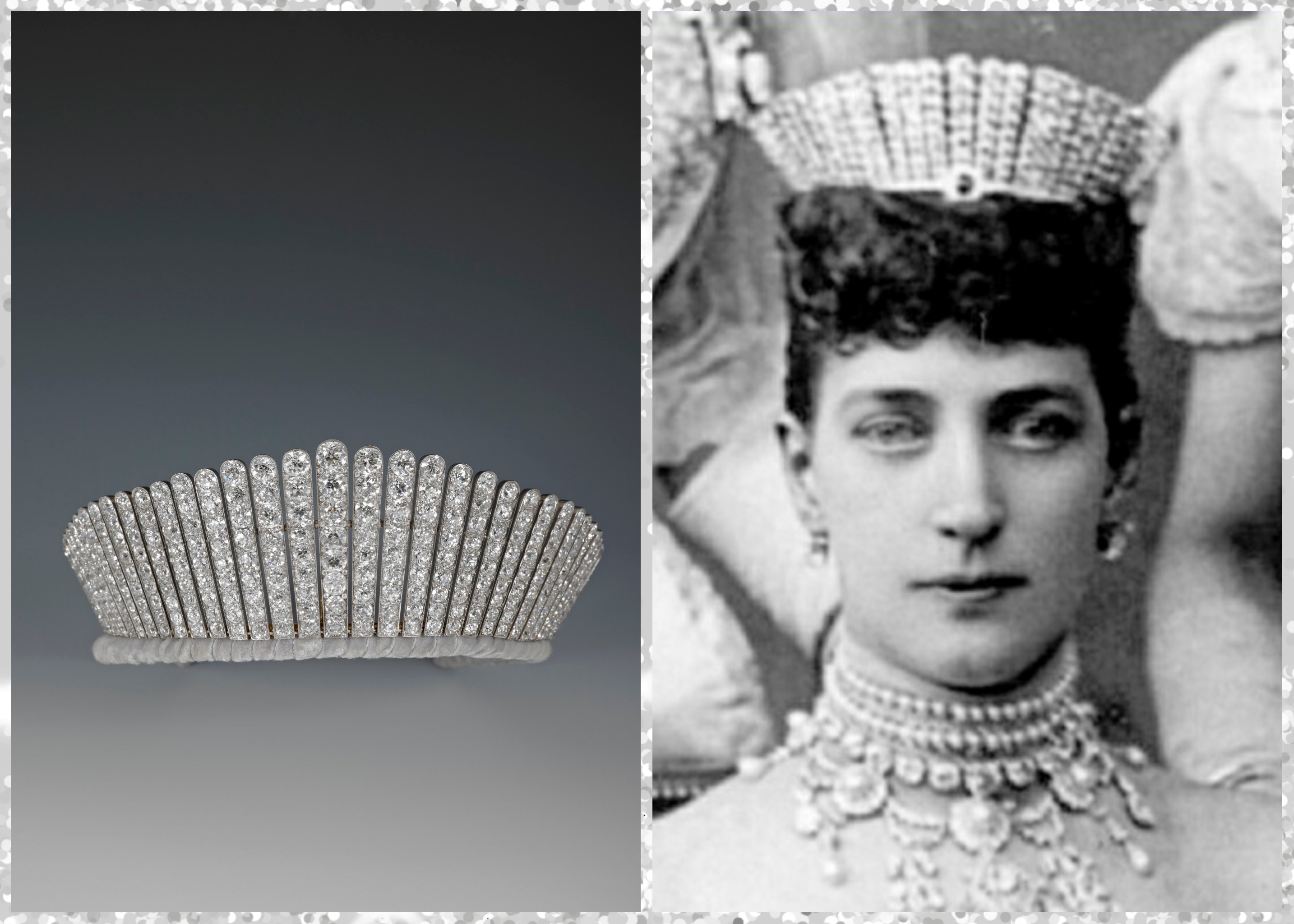
Also present at Philip’s ceremony are the Queen Mother and Princess Margaret.
Season 2 Episode 4: Beryl
‘Beryl‘ focuses on the highs and lows of Princess Margaret’s love life. We’ll brace ourselves for the mystery tiara but first another new addition to the show:
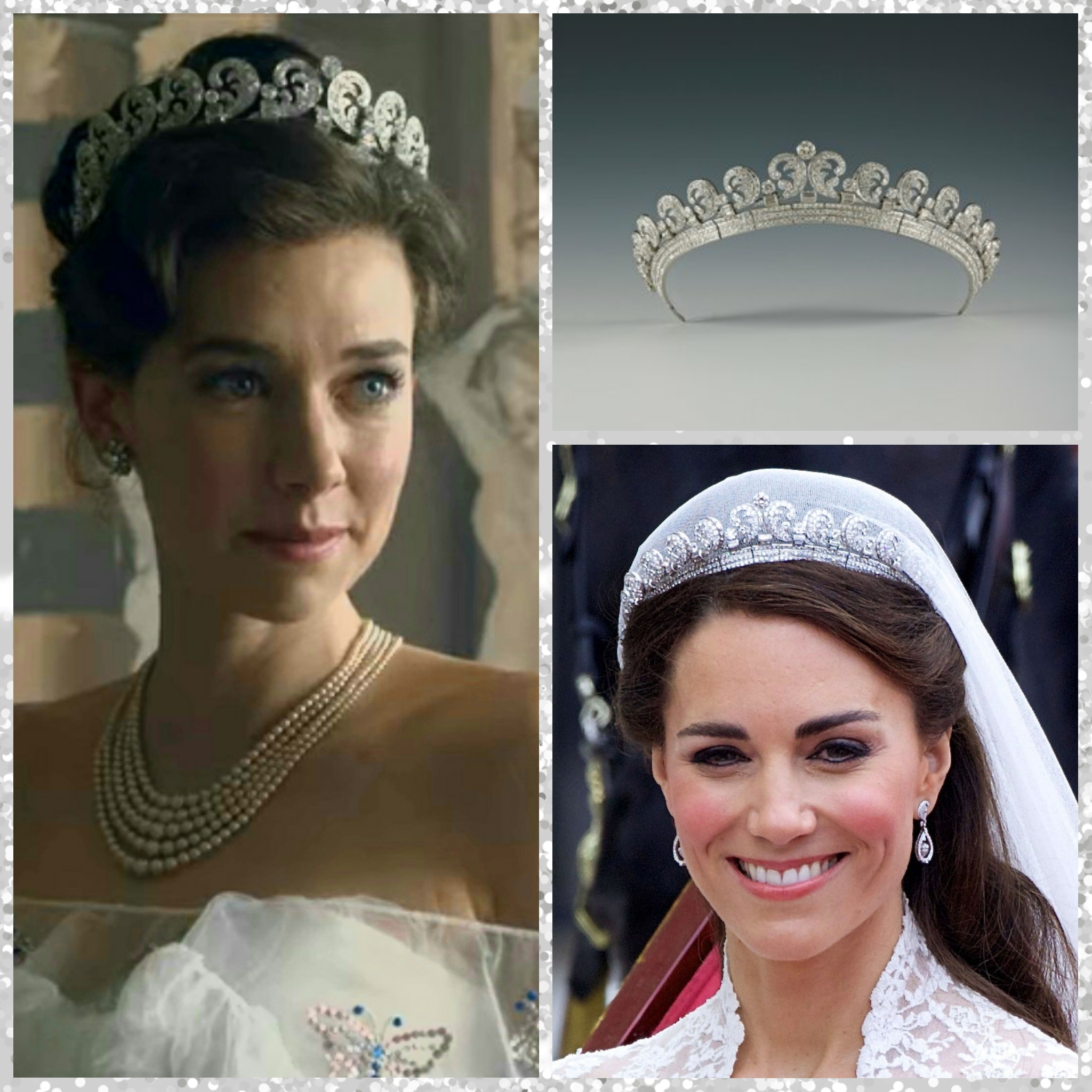
The replica may be a little oversized, but the tiara in question is the Cartier Halo Tiara or Queen Elizabeth’s Halo Tiara. Made by Cartier in 1936, Albert, Duke of York bought the tiara for his wife, Elizabeth, not knowing that within a month of the purchase they would be King George VI and Queen Elizabeth. The tiara was gifted to Queen Elizabeth II for her eighteenth birthday but often borrowed by Princess Margaret who wore it at her sister’s coronation. Most recently, it was worn by Kate Middleton at her wedding to Prince William.
Margaret wears it again for what should be the announcement of her engagement to Billy Wallace, but the announcement is not to be after Billy reveals he’s been romping with other women. Margaret breaks it off with a rather epic speech and attends her sister’s anniversary dinner alone. Historically, Margaret was briefly engaged to Billy Wallace but they broke it off after he revealed he’d had an affair.
At said anniversary dinner, Elizabeth is looking pretty fantastic in Queen Alexandra’s Kokoshnik.
Margaret’s mystery tiara doesn’t appear in the episode, but we’re still treated to an old faithful towards the end…
Season 2, Episode 7: Matrimonium
We’re a little tiara-light for episodes five and six but episode seven brings us another new addition to the series, as well as Prince Andrew. At the end of the episode, Princess Margaret marries Anthony Armstrong-Jones. In a move she claims that will shock the establishment to the core, she weds the son of the Countess of Rosse in Westminster Abbey. A society photographer, Etonian ‘Tony’ met the princess at the home of Lady Elizabeth Cavendish. Shaking the establishment to the core, indeed.
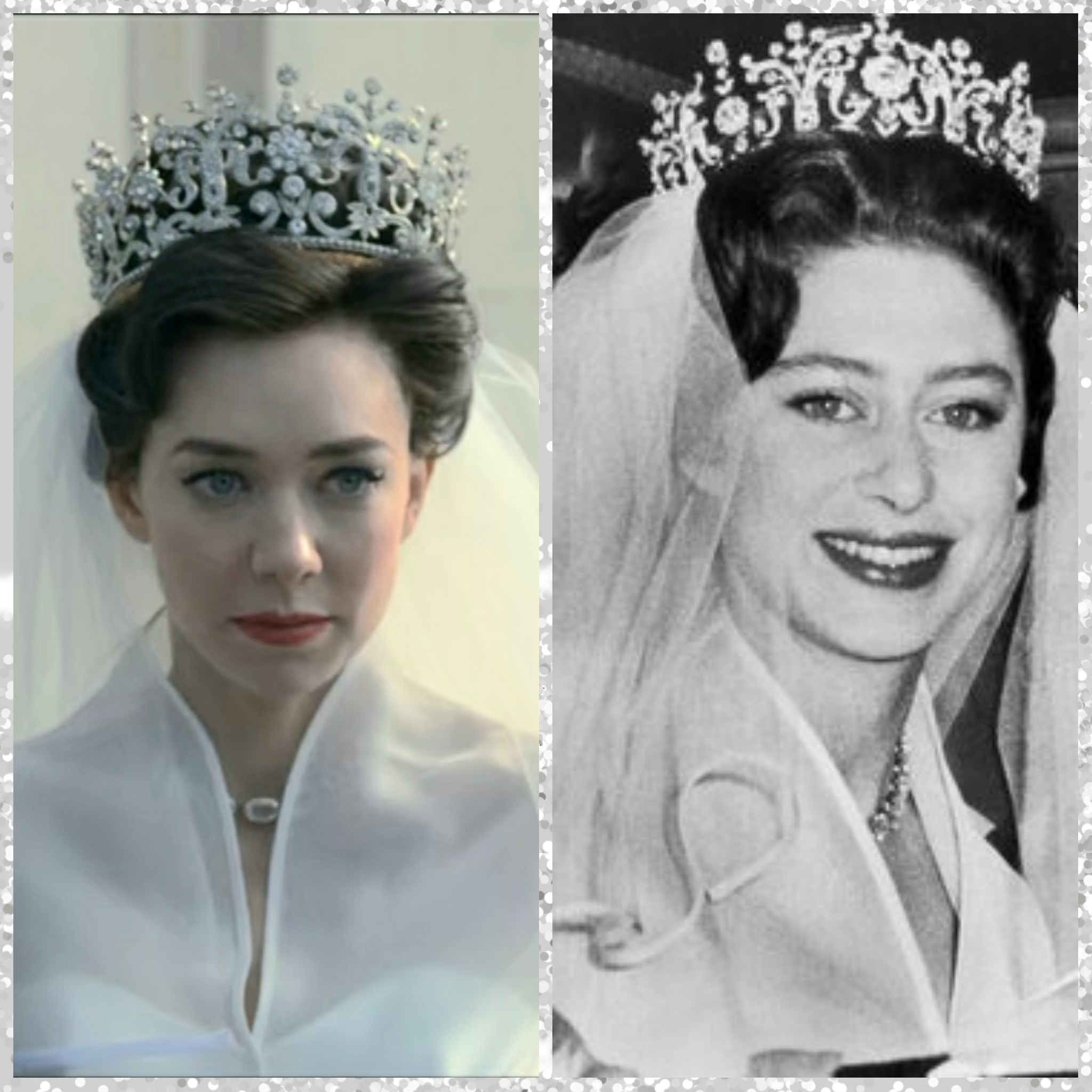
Breaking with tradition, Margaret did not borrow one of the many heirlooms for her wedding day, and instead actually bought the tiara that she wore. The Poltimore Tiara was originally bought by Lady Poltimore from Garrard in 1870. She wore it for the coronation of King George V, and like many pieces was able to be worn as a necklace or a brooch, as well as around the head.
Margaret bought the tiara from Lady Poltimore’s descendants and wore it frequently before and after the wedding. After her death, it was auctioned off with other pieces of her private collection and fetched almost a million pounds, though its current owner is unknown.
Season 2, Episode 8: Dear Mrs. Kennedy
Only one tiara present in an episode devoted to covering Elizabeth’s relationship with President Kennedy’s wife Jacqueline, and it’s one we’ve seen before but with a setting we have not.
Elizabeth wears the Grand Duchess Vladimir tiara with the only setting we haven’t seen yet; the Cambridge emeralds. Originally acquired by Princess Augusta of Hesse-Kassel, Duchess of Cambridge (who you’ll recognise from the portraits with the Cambridge Lover’s Knot) in a raffle of all things, the emeralds became known as the Cambridge emeralds. Augusta had them adapted into several different pieces of jewellery and upon her death these pieces and the remaining stones were inherited by her daughter, Mary, Duchess of Teck. Mary was the mother of Queen Mary, but upon her death the jewels passed to her son, Prince Francis of Teck.
Francis had no wife to give them to, so instead he passed them on to his mistress, Lady Eleanor Kilmorey. When Francis himself died in 1910, he willed the emeralds to Lady Kilmorey. Queen Mary was, shall we say, displeased. Mary managed to buy back the emeralds although it seems that Lady Kilmorey managed to keep hold of at least one piece. She was frequently seen wearing an emerald brooch which she later gave to her daughter-in-law. Apparently, when the daughter-in-law wore the brooch to a wedding in 1922, Prince Adolphus, Marquis of Cambridge, brother to Francis and Queen Mary, snubbed her at the sight of it and refused to acknowledge her presence.
As for the other stones, Queen Mary had them adapted for various pieces, as she was wont to do. This included having Gerrard create interchangeable droplets that could be worn with the Grand Duchess Vladimir tiara.
This is the last tiara we see Claire Foy as Elizbeth wearing. The remaining two episodes of the season focus on personal conflicts and relationships within the royal family, over state functions. But, there are two more seasons to look at, and eventually another two after that. So we have that to look forward to.
If you’re interested in royal jewellery, might I recommend the absolutely fabulous blog The Court Jeweller.
Picture credits
All images from The Crown were terribly screenshotted by myself from Netflix and mostly formatted/collated through the app PhotoGrid.
Beyond that we have:
- tatler.com: Elizabeth II’s wedding
- rct.com: Queen Mary’s Diamond Fringe Tiara
- tiara-mania.com: Queen Mary of the United Kingdom’s Lover’s Knot Tiara
- today.com: Catherine, Duchess of Cambridge
- worldroyalfamily.blogspot.com: Diana, Princess of Wales
- townandcountrymag.com: Queen Mary Lover’s Knot
- Regencyhistory.net: Princess Augusta of Hesse-Kassel
- rct.com: Imperial State Crown
- rct.com: Elizabeth II
- tatler.com: Grand Duchess Vladimir Tiara
- dailyexpress.com: Queen Elizabeth and Princess Margaret
- tiara-mania.com: Princess Margaret
- tiara-mania.com: Meghan, Duchess of Sussex
- jck.com: Elizabeth II
- rct.com: Prince Frederick’s coronet
- wikimedia: Prince Frederick
- rct.com: Queen Alexandra’s Kokoshnik
- townandcountrymag.com: Queen Alexandra
- rct.com: Queen Elizabeth’s Halo Tiara
- Glamour.com: Catherine, Duchess of Cambridge
- townandcountrymag.com: Princess Margaret
If you’d like to join me for more fun and games in picking apart history, and other behind the scene tangents, you can support me via my Patreon.


